Cruise Ship Engine Room (Everything You Want to Know)
Disclosure: This post may contain affiliate links. We may receive compensation when you purchase via my links at no cost to you. See my disclosure for more information.
Cruise ships require a lot of power to sail and operate. The cruise ship engine room is both mysterious and fascinating because it’s hidden from passengers.
Passenger ships have come a long way from sails and steam engines. Modern cruise ships use diesel-electric engines, while newer cruise ships are moving towards more environmentally friendly solutions like liquified natural gas.
Here’s everything you need to know about a cruise ship’s engine room.
Table of Contents

Where is the Cruise Ship Engine Room?
The engine rooms on cruise ships are located on the lower decks, between the midship and the aft. The engines aren’t quite at the back of the vessel but closer to midship.
There are several reasons for keeping the cruise ship engine room away from passenger areas.
- Stability : Placing the engines and heavy equipment below sea level helps keep the ship stable and prevents cruise ships from tipping over .
- Noise : Engine rooms are extremely noisy. Naval engineers compensate by incorporating sound reduction features and noise dampeners. However, the sound and vibration wouldn’t be pleasant for cruise ship passengers.
- Security : The engine room spaces are in crew-only areas for safety and security purposes.
Most of the heavy machinery on a cruise ship is located on the lower decks, just above the keel. The positioning of the engine room, other machines, and technical equipment give the massive vessels a lower center of gravity.

Although you might envision the engine room as a massive open room running the ship’s length, the lower decks are divided into several water-tight compartments. One compartment may house the cruise ship water fresh water systems , another for the main engines, and another for the air conditioning.
The division of the engine room into separate compartments is for safety. Dividing the engine room into different containers makes it easier for the ship to contain the damage if there’s a fire or leak in the hull.
Cruise ship fuel tanks are also on the lower decks, but they are kept separate from the main engines.

Crew members can monitor the ship’s systems from the engine control room. From the operation control center, crew members monitor the ship’s systems and act as a central area for maintaining the technical equipment on the cruise ship.
Every piece of equipment can be monitored from the engine control room to ensure the cruise ship runs smoothly.
The room is monitored 24/7 by watchkeeping teams. Each crew member is assigned specific machinery. For example, one person may be responsible for the freshwater generators and water pumps and another for the fuel oil systems.
How Big is a Cruise Ship Engine?

A cruise ship engine room spans several decks and holds the ship’s engines, fuel tanks, water systems, generators, control room, engine workshop, air conditioning, and other essential navigation systems.
Modern diesel-powered cruise ships have between four to six medium-speed (500 revolutions per minute) engines . Each engine can generate upwards of 25,000 horsepower or nearly 18.5 megawatts.
The engines on a cruise ship can be up to 45 feet long, 27 feet high, and weigh up to 275 tons .
These massive engines can propel cruise ships at an average speed of 18-22 knots .
Cruise Ship Engine Technology
Cruise ship engine technology has evolved from wind and sails to newer liquified natural gas technology.
We’ll cover some of the most popular technologies used by cruise ships.
Steam Engines

When the cruise industry began in the mid-1800s, vessels were propelled by steam engines.
Steam engines had boilers that used wood for fuel. Later steam engines used coal.
The boiler produced steam which created pressure in a pressurized system. The pressure moved pistons which drove the propeller shaft.
The Titanic was powered by two huge triple-expansion steam engines and a small propeller. ( Source )
Diesel Engine s

Diesel engines propel most modern ships. Cruise ships may have four to six medium-speed (500 rpm) engines producing 8-10MW each .
Diesel engines work on the same concept as steam engines. Rather than steam, the ignition of diesel fuel pushes the pistons up and down, turning the crankshaft attached to the propeller shaft.
Many of today’s diesel-engine cruise ships also employ a shaft generator to generate electricity for shipboard services, like lighting.
A shaft generator converts the circular motion of the propeller shaft into electricity. However, shaft generators only operate when the ship is moving. And can’t generate electricity while docked in port.
Diesel-Electric Cruise Ship Engines

Almost all new diesel-powered cruise ships use diesel-electric engines.
The engines work the same as a traditional diesel engine, but rather than connecting to the propeller shaft – diesel-electric engines connect directly to large generators .
A diesel-electric engine has one job, generating electricity.
The electricity produced by the engine is used to power the ship’s propellers.
These engines provide greater efficiency than traditional diesel engines.
While connected to a generator, the engines can run at their most efficient settings regardless of the travel speed . Whether the ship is sailing at 10 or 20 knots, the engines can operate a peak efficiency.
Diesel-electric engines are popular because of their ease of control, low noise, minimal vibration, and relatively compact size compared to other forms of propulsion.
Marine vessels that run on diesel power must carry exhaust-treatment systems and catalytic-reduction equipment to reduce the environmental impact of the ship.
Gas-Turbine Power System

Royal Caribbean Group was the first company to experiment with gas-turbine systems.
Compared to diesel engines, gas turbines offer several advantages, including:
- Lower environmental impact.
- More reliable.
- Take up less space.
- Gas engines require a smaller maintenance crew and less inventory.
The heat generated from the engine is recovered and used to produce electricity for other onboard systems, such as air conditioning and water heating.
Despite their advantages, gas propulsion is not widely used in the cruise industry. Gas-powered ships are faster, but most cruise ships don’t travel faster than 22-25 knots .
Diesel engines have greater fuel efficiency at slower speeds , and the high gas price compared to diesel makes them more costly to operate.
LNG Powered Ships

Many new cruise ships are propelled by liquified natural gas (LNG).
LNG is the cleanest fossil fuel currently produced. According to Cruise Critic , LNG-powered cruise ships can “reportedly reduce sulfur emissions by as much as 99 percent and nitrogen oxide emissions by up to 85 percent.” LNG can reduce carbon emissions by up to 20 percent .
The special engines of LNG-powered cruise ships use natural gas cooled to approximately -260°F. Once cooled, the liquid form of natural gas is about 600 times denser than natural gas , making it easier to transport.
Carnival Cruise Line announced the first LNG-powered vessels in 2015, using a “dual fuel” design. The ships can burn both liquified natural gas and marine fuel, reducing the required fuel storage space.
AIDAprima became the world’s first LNG-powered cruise ship on her debut in 2016.
Natural gas is purer, cleaner, more efficient, and cheaper than other fossil fuels . But it’s a relatively new technology, and not all ports have the facilities for refueling LNG-powered ships.
Because natural gas burns cleaner than other fossil fuels, the engines require less maintenance. But LNG has a lower fuel density than diesel, so LNG vessels need fuel tanks that are twice the size.
Emergency Generators
Every cruise ship has an emergency generator to maintain vital electrical power in case of engine failure.
The emergency generators are located away from the main engine room, usually on a higher deck. Their location isolates them from catastrophic damage in the engine room (for example, a fire).
The generators can operate critical navigation systems, emergency lights, and other vital equipment. But emergency generators can’t power the ship .
Larger ships may have multiple emergency generators. But due to the size constraints, they can’t produce the same power as the main engines and cannot propel the ship.
What happens if the generator fails?
Cruise ships have several redundant systems to ensure the safety and security of passengers. If the generators fail to work during an emergency, cruise ships have an emergency battery backup to power the most critical systems for up to 24 hours .
Shore-to-Ship Power Supply
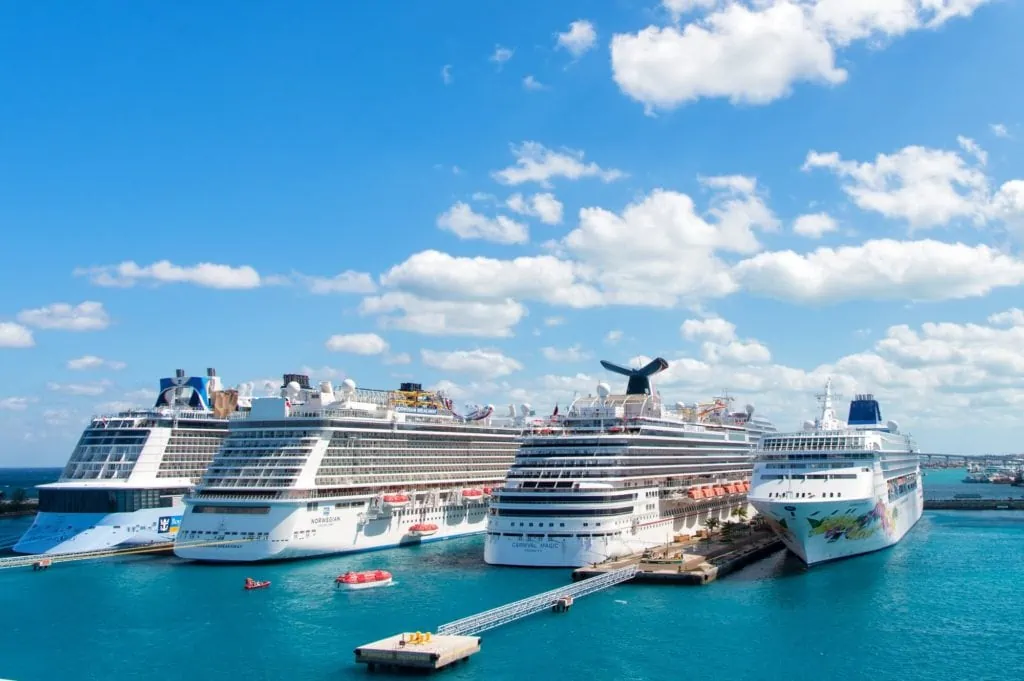
Despite innovations in engine technology, cruise ships produce a lot of pollution.
To further reduce ships’ environmental impact, many cruise ships can connect to the cruise port’s power grid , known as “shore-to-ship power” or “cold ironing.”
In the past, cruise ships kept their engines running while docked to generate electricity for shipwide services.
But most of the energy produced by the ship’s engines goes towards powering the propellers, and running the engines while docked created massive energy waste.
Some cruise ships used smaller generators to power the hotel and amusement functions. The smaller generators allow cruise ships to shut off the main engines in port, reducing pollution.
Modern cruise ships are equipped with systems to “plug in” to the local power grid. Even some older cruise ships are being retrofitted to allow for shore-to-ship power.
Not all cruise ports have facilities to enable shore-to-ship energy. But many larger cruise ports have dockside electrical hookups that allow cruise ships to shut off their engines and run on the city’s electrical grid. The technology reduces harmful emissions by up to 95% while ships are docked .
Considering how much time cruise ships spend docked at port, it significantly reduces sulfur and carbon emissions.
How Loud is the Engine Room of a Cruise Ship?

A cruise ship engine room is incredibly noisy, exceeding 173 decibels . At this noise level, the noise in an engine room can cause immediate damage to your hearing without proper ear protection.
For reference, a gunshot is 130 decibels.
Engine rooms have insulation and sound-reducing technology, so it’s not as noisy. To prevent hearing damage, crew members must wear hearing protection when entering the multi-story engine room.
But guests don’t have to be concerned about the noise.
Thanks to the insulation and sound dampening, you’ll only hear a slight “purr” if you’re near the engine room.
You may feel the engine’s vibration if your cabin is on the lower decks, near the aft . On most ships, the noise isn’t enough to cause any annoyance or trouble sleeping.
But if you’re a light sleeper, accommodations near the engine room are among the worst cabins on a cruise ship .
Where are the Fuel Tanks?
The fuel tanks are located below the passenger decks , near the engine room. The fuel is stored in double bottom tanks.
How Much Fuel Can a Cruise Ship Hold?
A large cruise ship of 1,100 feet in length can hold between 1 to 2 million gallons of fuel .
It’s enough to power the cruise ship for up to two weeks of sailing without refueling.
Are There Cabins Near the Engine Room?
Newer cruise ships have a large gap between the cruise ship engine room and passenger cabins to minimize noise and vibrations.
However, you may still find cabins reasonably close to the engine room.
If you book a cabin near the engine room, you can expect to hear some noise and feel the vibrations caused by the engines . However, cruise ships use sound-dampening technology and insulation to minimize noise pollution.
The engines are typically cheaper because most passengers avoid booking cabins next to the engine room.
Cabins near the cruise ship engine room aren’t noisy enough to cause annoyance or sleeping issues.
If anything, the vibrations caused by the engines are more likely to cause annoyance over the sound of the engine .
How Much Fuel Do Cruise Ships Use?
It takes a lot of fuel to power a cruise ship.
The average cruise ship uses around 18.3 gallons of fuel per minute or 1100 gallons per hour . ( Source )
Marcello De Lio
Leave a Reply Cancel Reply
Your email address will not be published. Required fields are marked *
Name *
Email *
Add Comment *
Save my name, email, and website in this browser for the next time I comment.
Post Comment
This site uses Akismet to reduce spam. Learn how your comment data is processed .
Trending now


This is How Cruise Ships Work
by Contractor | Nov 24, 2020 | resources , Travel Tips | 0 comments
Are you wondering how cruise ships work? Whether you’re planning a trip or just curious about a cruise ship’s technicality or even the logistics, it’s always intriguing to find out how massive ships like work. How does a cruise ship work?
First and foremost, a cruise ship’s heart is in the engine of the vessel. The engine’s design, paired with proper fueling, provides the power for the ship’s mobility and all the entertainment aboard. The ship’s engineering and the logistics of running a cruise company play a role in shaping how a cruise ship works overall
If you are an engineer curious about a ship’s mechanics, this is an article for you. Fortunately, if you’re just a curious traveler wondering how a cruise vessel will shape your next trip, this is also for you, so read on. There is so much to a cruise ship other than the cocktails and fun parks on top. This will be an eye-opening article for all audiences.
How Do Cruise Ships Work

To the ultimate question, “how a cruise ship works,” let’s dive into how it works mechanically. What are the technical and mechanical aspects of a cruise ship? What does an engine do? How does a massive ship provide light, food, entertainment in the middle of an ocean? Is the water safe to drink?
Then, after reviewing how the cruise ship’s mechanics work, the answer to how a cruise ship works logistically can be answered. How do companies make a profit from these vast ships? How do the ships prepare for new passengers?
Technical Aspects of Cruise Ships
The technical aspects are a vital part of a cruise ship, so it will be first visited. Not to state the obvious, but the ship’s heart is shaped by the crew and the engineers that have put many hours and dedication into making a cruise ship work.
This is article will reveal the true hidden layers of what makes it all work starting from ground zero, the heart.
Technical Aspects
If you want one thing in a cruise ship aside from the cocktails and a nice tan, it’s the vessel’s stability and durability. Whether you are traveling through an unexpected storm or cruising on a gentle wave, your cruise ship should be the most stable in all situations.
How are cruise ships stabilized? The general idea for balancing and maintaining buoyancy is distributing the weight throughout the ship correctly, and of course, displacing the right about of water as it moves. So, let’s first talk about one of the most massive machinery onboard, the engine. Where does it sit and how does it run the cruise ship?
Engine Rooms
Where are the engines located? You guessed it, most heavyweights, such as engines, are found as low as possible in the lower decks, ground zero. For most cruise ships, the engines are close to the keel. The structural keel is the most closes to the bottom of the vessel and the ship’s wide hull. It runs the length of the vessel down its centerline and in most ships, you won’t have to go far to find the engine rooms.
Just because it’s placed low in the ship doesn’t mean it doesn’t take a lot of space. For all the ship’s power, the engine rooms can take up several decks high and are generally divided into several compartments. It may not feel like an open massive space, but it is truly the heart of the ship and the design of the rooms and placement are critical.
Usually, the primary concern for most ships is have engines and machinery compartmentalized for safety and avoiding fire hazards. Compartmentalized and labeled rooms make maintenance simpler and enhances safety for unprecedented accidents.
New legislations also support the requirement for compartmentalization. Ships are required to have at least a duplicate of equipment and at least two separate spaces for engines. So, what about these engines? Why are they so important and why do ships need so many of them?
Power and Engines
Just to answer those questions, we’ll have to visit more fundamental questions such as: How do the engines power a giant cruise ship? How does it help the ship propel forward? Are there specific engines that power different parts of the cruise? Out of many questions regarding the engines, the answer starts with the main engines.
The main engines are the engines that produce the majority of the power for the cruise ship to move. Depending on the type of vessel, the main engine connects to different parts of the propelling power. From traditional steamboats, to diesel electric, the engine is the fundamental powerhouse for the entire ship on the sea.
The following table is a general overview of how engines on different types of vessels are connected to the ship’s requirements.
So How Do These Engines Make the Ship Move?

As shown in the table, depending on the vessel type, the engine will provide power to different aspects of the ship. More or less, everything is distributed to operating proportions, but the key mechanics differ from one to another.
Diesel may be something more familiar to what we saw in old movies with steamboats. Even in modern days, we use similar mechanisms, if not labeled the same. The main difference is the source of pressure, which can be the traditional steam, or a fuel ignition.
Whether it is steam (traditional) or fuel ignition, the pressure generated from either push the pistons up and down in the vessel. These pistons connect to crankshafts through gears, which turns the pistons.
The crankshaft connects to the propeller through a long propeller shaft and gears, which further determines its speed in traditional diesel-powered vessels by steam pressure. Generally, the faster the pistons move up and down from the pressure, the quicker the propeller shifts would move.
With modern designs that control the propeller speed, engineers placed the gears in between the propeller and the engines which further enhances efficiency for both engines and propellers.
Again, although the majority of the engine provides electricity to the propeller shaft, electricity must be provided to the rest of the ship for entertainment. Often, options such as a shaft generator offer power to outlets such as lighting the dining and general appliances onboard while in motion.
Diesel-Electric
Diesel-electric is another form of vessels that are found commonly with conventional diesel vessels. Unlike the conventional diesel, diesel-electric engines are connected directly to the generators that provide the electricity for the propellers and main generators.
This electricity also provides direct power for the ship’s lights, appliances, and much more.
Environmentally Friendly Power

On a side note, if the thought of diesel in the ocean disturbs you, there is some good news! Thankfully, more and more environmentally friendly options are appearing for cruise ships. For example, liquified Natural Gas (LNG) is an alternative method for powering ships that burns natural gas for power.
Using natural gas could reduce nitrogen oxide and carbon dioxide emissions significantly! With green-oriented companies, more green cruises have been released in the past few years.
That being said, if you are looking to book a trip, be on the lookout for green cruising opportunities! Onboard, you can also find environmentally conscious crew members and less-waste policies.
Source: CruiseCritic , Windstar Cruises , Green Cruises
Fuel Consumption
So, how does fuel play a part in powering the engine and the cruise ship? Let’s go back and visit what an engine does. An engine generates electricity to the propellers by supplying power the propulsion motors. How do they get the electricity and what makes an engine work? Most likely fuel and ignition (besides the steamboat example from before).
How much Fuel?
In general, a large cruise ship can consume up to 250 tons of fuel a day, which is close to 80,000 gallons a day. For medium size cruise ships, consumption can still range up to 150 tons of fuel a day.
Onboard, a ship may carry up to 1 to 2 million gallons of fuel, depending on the vessel size. Most of the power, which can be close to 85%, goes to the propellers, while the rest goes to keeping the cruise lit and comfortable for the passengers and crew members.
While passengers dine and enjoy their cruise aboard, crew members are constantly maintaining the proper fuel levels and providing proper power for the ship. As for the captain of the ship, he also has several variables to keep in mind to control fuel consumption and safety.
Fuel consumption may vary for several reasons, just like when we are driving our cars (but with more variability). For example, depending on where the wind is hitting the ship, the fuel consumption can go 1 – 5% over the average consumption rate.
Here is a short list of variables that the captain is keeping track of:
- Speed of the cruise
- Sea conditions (vs. sailing direction)
- Weather (including the direction of the wind)
- Size of the ship
- Engine (Gas turbines, diesel-electric, diesel, or electric)
Source: Windstar Cruises , Cruise Mapper
Overall, the fuel, power, and engine, are all functions of making the magic happen. Starting from the design of the engine, to the crewmembers and captain maintaining the fuel and power consumption, a lot of action happens behind the scenes while passengers are onboard during vacation.
Floating and Buoyancy

Now that the ship is powered, how do we ensure that it floats? How do these massive machineries, ice-skating rinks, restaurants, and bars float on water while keeping thousands of passengers safely onboard?
While the cruise ship constantly pushes the water out of its way when moving forward, the water being pushed will try to come back to its place. This displaced water pushes back with a force on the vessel which lets the cruise ship stay afloat.
This is the general idea when engineers designed the hull of the ship. This ratio has to be calculated when designing a ship and has to be correct. If you get a chance to see the hull of most ships, they have a wide U-shape hull at the front to maintain the displacement.
In addition to basic buoyancy principles, an engineer must also consider the ship’s average density. This means that the ship’s general open spaces must be considered on top of the vessel’s average weight, so the vessel remains “less dense” than the ocean’s (usually salty) water. A great example is a rock sinking vs. a beach ball floating on water.
Source: Express
Water Onboard
So the power, fuel, engine, and buoyancy are the fundamentals of the ship. What about the details of the cruise ship such as the water in your shower? Is it salty? Is it fresh? Where and how does that come to your room without running out.
In general, most cruise ships have a steam-evaporation system. Water is pumped and desalinated before going to your room. During this process, your water is distilled and desalinated using a reverse-osmosis system and filtration system.
Distillation and desalination process uses a purification system to take all contents out of the water. This is generally not healthy to drink, so this water is mineralized and chlorinated for taste and safety.
Additionally, some ships have water brought onboard for laundry and other maintenance purposes. Generally speaking, the water onboard available for drinking are tested and checked for purification. If you are ever in doubt, check with a crew member to ensure the water is safe for consumption.
Is the Water Safe?
The answer to your ultimate question is, no, the water you are drinking is not toilet water. Regulated by the Maritime Organization laws, all “toilet water” must be treated and discharged into the ocean at a specific distance from the land. This water is never treated and recycled for passengers to use again.
On a side note, if you feel uncomfortable drinking this water, bottled water will most likely be available onboard for purchase. If you need special water for medical needs, you will most likely be able to bring a few bottles on board by notifying them ahead of time.
Now that we have reviewed how cruise ships work mechanically, let’s dive into the ship’s logistics. How do they work? Who’s working, how is it supplied, and how are they so cheap? Or perhaps, why are they so expensive? All of these questions come down to logistics.
General Logistics
Depending on your opinion and type of cruise you may have signed up for, you may think that your cruise is way under or over-budget. The cruise companies measure these decisions and prices to minimize cost and maximize returns (of course).
For example, cruise ships avoid fines by taking specific lines. They must often save fuel and hiring a knowledgeable captain who can make these decisions and keep passengers aboard safe is essential.
So, what are the different divisions of a cruise vacation? Are some better than others?
Mainstream, Premium, and Luxury

If we broke down cruises into 3 main categories, we could look at the mainstream, premium, and luxury lines of cruise types. You will often see categories within each of these types, but let’s break them down into the major categories for simplicity.
First, we will start with the mainstream cruise lines. These are cruises that are readily available, common, and well-known by the public with reasonable ticket costs.
Generally, these cruises’ primary business is through the onboard casinos, spas, shopping, and drinks. They suit the needs of most passengers. To make maximum profit, companies design these cruises by providing readily available entertainment on board. Most passengers are estimated to use 500$ onboard for their vacation experience.
Onboard, you will find general amenities, restaurants, bars, pubs, nightclubs, shopping, theaters, cinemas, swimming pools, gyms, karaokes, libraries, and even museums! These are great for big parties and are generally the biggest ships at sea.
Examples of Mainstream Cruise Lines that are known as “floating resorts”:
- Carnival Cruise Line
- Royal Caribbean International
- Norwegian Cruise line
- Lindblad Expeditions
- Amawaterways
Mainstream cruises are great for
- Group of friends
Source: NancyandShawnPower , Fodors , and Wind Rose Network
Premium lines are perfect for adults or those that are retiring. The brilliant catch is that many have policies of “no kids allowed,” making it an excellent selling point for adults who need some peace and quiet. These cruises make money upfront by offering more access to ports and offering the serene luxury.
Premium cruises generally have a refined style in comparison to mainstream cruise lines. Activities are more focused on lifestyles. For example, you may find computer classes or a language-learning class. Besides, these ships still offer resort-style pools, game nights, bingo, spas, gyms, and maybe even a jazz night.
The perks for a premium in comparison to the mainstream is the higher quality of cuisine. Usually offering specialty restaurants and quality chefs, the price may be higher, but the overall quality is higher. The rooms at premium cruise lines are also superior, often offering suites and rooms with balconies.
Examples of Premium Cruise Lines
- Princess Cruises
- Celebrity Cruises
- Holland America Line
The popular audience for Premium cruise lines:
- Older Adults
- Sometimes family-oriented
Source: Fodors
Luxury lines are pricier yet offer the best-selling point, fewer people onboard with a luxurious experience from beginning to end. The more expensive tickets provided to only a few hundred passengers make a profit for the company with the much higher ticket prices.
There are abundant space and a deluxe ship that will greet you as a valued guest from beginning to end for the high price. No doubt, one will fall for such an exquisite experience that starts from fine dining of caviar and foie gras to personal service available at one’s fingertips.
Course meals are offered from a full restaurant menu in your stateroom and served with limitless wine. Most interiors are luxurious and elegant, with rooms that are large and overlooking the sea.
Amenities range from gyms, spas, pools, and low-key entertainment. Generally targeting a niche group, most luxury cruise lines do not allow children.
Examples of luxury cruise lines:
- Windstar Cruises
- Paul Gauguin
- Silversea Cruises
- Crystal Cruises
- Oceania Cruises
Source: Cruise Critic
Many corporations own several of these different targets to make the most profit. Additionally, by corporations owning various cruise types, they can also hand down older ships throughout their other brands.
Logistics throughout the year

In addition to managing several types of cruises, there are numerous ways cruises have to operate to maintain their profits and not waste money through resting and selecting the wrong routes.
For example, cruise lines generally have high sales in November through April by Americans. The cold Americans usually take a warm vacation away from winter for a trip to the Caribbean.
What about other times of the year? Staying on seas without business is a considerable loss in revenue and usually unheard of. So, what do they do? They sell repositioning one-way tickets in April!
Generally, towards the end of April, you will start seeing two-week trips from the Caribbean to Europe. Typically, these trips can range from any state on the Eastern Coast of the United States to European countries.
Switching over/Cleaning
When there are one-way trips, there also needs to be exceptional coordination for a short turnaround between trips. When the cruise ships get to the destination, all hotels, theaters, dining, laundromat, and parks are cleaned and reset for the next people to come on board within half a day!
How do they do it?
During night-time, luggage and bags are ready ashore for passengers to check out. Meanwhile, all the trash is dumped, and the trash containments are cleaned, crew members switch, fuels are refilled, and food is refreshed with new inventory.
Remember the 1 to 2 million gallons of fuel to refill? This process, called bunkering, is a whole-team effort and is completed before the ship is ready to travel again.
A small boat, a “barge,” brings fuel to the 400 ports fueling for ships.
- Barge secures to the side of the cruise ship
- Connects a hose between the ship tanks
- Pumps fuel while watching guard
When passengers load off, then the cleaning crew comes to clean the rooms. While the ship is pampering, they complete paperwork from the first trip, fulfill any necessary maintenance, redecorate rooms, and start preparing and cooking food and lunch for the next set of passengers coming on board.
Soon, the ship is reloaded with happy passengers and starts to move again. They make their profits from when the Casinos start, and food is served.
Crew Members
This brings light to the less noticed crew members. The ones that make all the magic happen. Generally, a cruise will have 1 crew for 2 passengers. Most of the crew members are working very long hours for several months.
In general, these crew ships are in their rooms when not on duty and do not get in the passengers’ way. How do cruises afford these crew members and their extended hours of work? The trick is that cruises can register in any country to abide by their labor laws. This is how they keep costs low, but there is a catch to that.
Crews and Destination

So, there is a catch, but it impacts your travel too. Did you ever wonder why cruises took less than expected stops? Not necessarily detours or emergency stops, but maybe a cruise led you to Ensenada or the Tabuaeran. This is due to the Passenger Vessel Services Act of 1886.
Why do cruises take weird detours?
Generally, a cruise ship can register any Labor law, as stated above. This makes it easy for cruise ships to pick a non-American country since it is cheaper and easier to fulfill (for business purposes). Unfortunately, if they choose this option, they must also abide by the Passenger Vessel Services Act of 1886. This act states that “No foreign vessel shall transport passengers between the United States.”
This means that if the cruise ship is registered under another country, they can never directly stop at an American stop if their initial take-off was in the United States. This is why you see stopes in Ensenada, for example.
For example, before Norwegian registered as American, if their cruise trip was to Hawaii from the motherland, they had to stop at Tabuaeran, a small island nearby.
When Norwegian registered as American, this let them bypass the Passenger Vessel Services Act. Unfortunately, this led the crew members’ service fees to rise, which led to higher ticket prices. If you want to watch how the above logistics work, check out this video !
A Cruise Ship Overview
Starting from the engine, fuel, and engineering to the logistics of companies, crewmembers, and governing policies, a cruise ship works in a marvelous way to shape every passengers’ experience abroad.
Thousands of crewmembers across various cruise ships, engineers of several centuries, and many hours of dedicated personnel make a cruise vacation work. Next time you are enjoying a cocktail on deck, remember that there is so much more behind the meaning of your cruise. There are so many parts that worked to make it happen! Enjoy and bon voyage!
Related Posts:

Submit a Comment Cancel reply
Your email address will not be published. Required fields are marked *
Save my name, email, and website in this browser for the next time I comment.

Privacy Overview

The Shipyard
For Those Who Love Ships
- Cruise Ships
How Cruise Ships Work (Part 3): The Bridge and the Engine Room
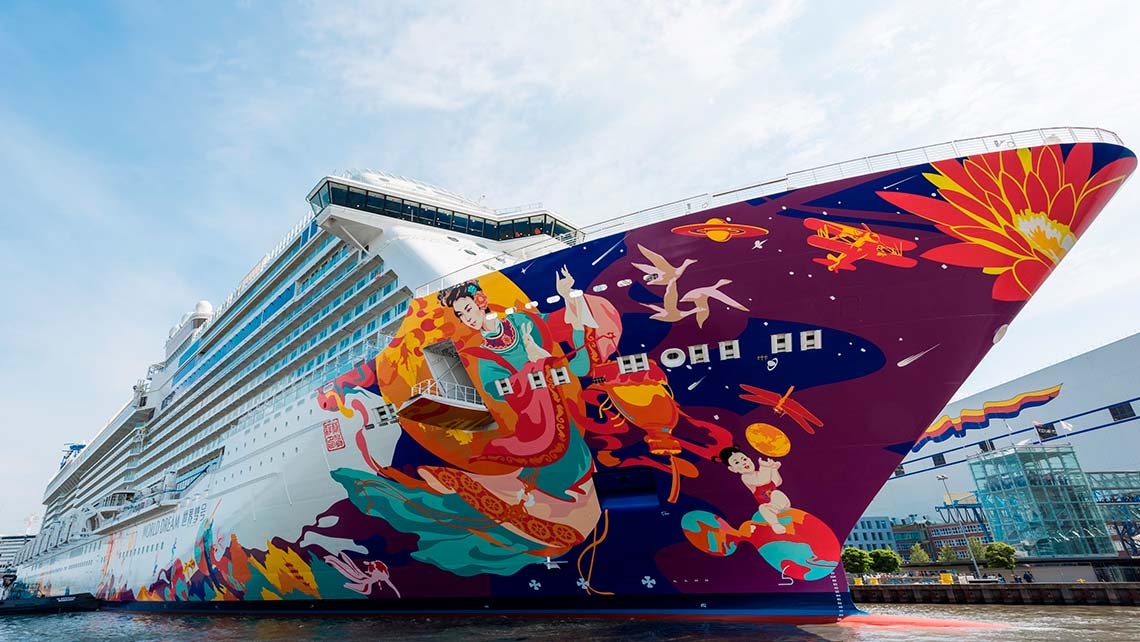
It’s like back in the days when we were little children. Grandpaw’s almost mystical tool shed was strictly off limits, but we were just dying to have a peek, weren’t we? Now that we are all grown up, Grandpaw’s gadgets are old news, but there is still a place or two on a cruise ship that remains like a pie in the sky for all of us obsessed by ships.
It’s the heart of the matter, it’s where it all happens, it’s the real deal. And if you are anything like me, you would gladly give away a day at the spa, a dessert buffet and even two, or the latest Marvel flick in the movie theater, just to spend a precious hour down in the noisy engine room of your favorite cruise ship. But life being proverbially unfair, modern cruise lines rarely allow their passengers to enter the bridge or the engine rooms of their ships, unless the visit is part of a specially organized guided tour. Some cruise ships have a window from which passengers can observe what’s going on in the bridge, but only if they promise not to disturb the officers. Which is really hard, when you badly want to touch everything…
So until the next time someone lets me out of sight and I make my umptieth attempt at trespassing to the engine room, let’s have a quick virtual tour of a cruise ship’s most forbidden and exciting parts.
The bridge is the brain of the ship. It is from there that the captain and his officers command and maneuver the ship, keep watch for other vessels or potential hazards, and navigate through the oceans.

For twenty-four hours each day, the bridge is occupied by two Deck Officers and two Able Seamen, traditionally in four-hour shifts. The main job of the Officer of the Watch is to monitor the ship’s systems and surroundings, and to ensure that everything is running safely and smoothly. During extreme weather, docking, or other special cases, the Captain of the ship is also present on the bridge to guide the deck officers.
The term “bridge” comes from the time of the paddle steamers, where a bridge was built above the two paddle houses that used to hold the paddle wheels. This way the skipper could observe both wheels, while moving freely between the two and giving out commands. On today’s cruise ships, the bridge is usually on the upper deck in the forward part of the ship and extends over the sides of the superstructure, allowing deck officers a view to the sides of the ship as well as down to the waterline. The side extensions are called bridge wings and often have a glass flooring for better visibility.

The bridge houses a number of important nautical devices and information systems for command and navigation of the ship.
Satellite Navigation
The signals emitted by special navigation satellites are picked up by the cruise ship through a special antenna. On board, a computer converts these signals into the exact position of the ship at a given time. On large ships, the position indicator is constantly recorded in a so-called electronic nautical chart.
Satellites also enable automatic positioning systems on modern cruise ships. The positioning system is controlled from the bridge and it uses GPS to ensure that the ship stays at a defined location. When the captain defines a position where the ship needs to remain for a while without anchoring, the system automatically maintains the ship in position by using the bow and stern thrusters.
Modern cruise ships carry a gyro compass and a magnetic compass. The gyro compass consists of a fast-rotating disk, usually positioned in a gimbal. It is a non-magnetic compass oriented parallel to the axis of rotation of the earth and thus indicates the north-south direction.

The gyro compass is more accurate and reliable than the magnetic compass and is therefore the primary reference point for steering the ship. The magnetic compass on board is more prone to inaccuracies and it serves only as back-up.
The word radar stands for Radio Detection And Ranging. Radars are devices that allow us to locate distant objects from a given location, regardless of visibility and weather conditions. The radar emits electromagnetic waves to an object, then receives back the reflected echoes from that object, and interprets them based on distances and angles. These interpretations enable us to determine where an object lies, and in some cases even what its contours look like. In the shipping industry, radars are used for monitoring traffic in ports and coastal regions, for collision protection, for collecting weather data, and for navigation.
Speed logs are devices that measure the speed of the ship. There are two main types of speed logs: Doppler logs and electromagnetic logs.
The Doppler logs send out underwater sound signals. When the sound wave reaches the sea floor, it gets reflected and then returns to the receiver of the log. Due to the movement of the ship relative to the seabed, a Doppler effect occurs and is evaluated by the device. As long as the sound waves can reach the bottom of the sea and return to the receiver, the Doppler log measures the distance travelled over ground. However, if it is no longer possible to use the seabed as a reference, the device uses particles suspended in the water, such as plankton and minerals, to measure travel through the water.

The electromagnetic logs create an electromagnetic field in the water around the ship, with the aid of a small alternating current and a transducer. A voltage proportional to the speed of the ship is generated in the water and is picked up by special sensors, which then transfer the information to an electronic device for interpretation. From the electronic device, the speed is then transmitted onto the displays in the bridge.
Echo Sounder
Cruise ships also have an echo sounder, a device used for the electro-acoustic measurement of water depths (sounding). The depth is determined by measuring the time between the emission of a sound impulse (water sound) and the arrival of the sound waves reflected from the bottom of the sea. The main purpose of echo sounders in cruise ships is safe navigation through waters.
Electronic Chart Display and Information System
The Electronic Chart Display and Information System (ECDIS) is a console, built into the bridge of modern cruise ships, which incorporates the main engine safety system, fire control system, monitoring and control system, power management system, propulsion control system and navigation and maneuvering system. The ECDIS allows for navigation of the ship without the need of traditional paper charts. Navigation can be done manually, automatically, or through the Navigation and Command System (NACOS).

The NACOS is the main software used to coordinate all factors that need to be taken into consideration, in order to navigate and maneuver the ship safely. The console is composed of a number of displays showing information from the radars and compasses, data about the course of the ship and planned maneuvers, the current status of the pitch of the thrusters, the speed of the ship, and anything else concerning the steering of the ship. An intelligent autopilot tracks changes in the behavior of the ship through navigational sensors. If the ship drifts off its course due to strong winds, for example, the system automatically responds to correct the change by sending signals straight to the engine room. Once the signal is received by the engines, the rudder or thrusters of the ship are activated and move to the position given by the system. The displays on the bridge show both the angle of the rudder or thrusters, as well as the rate and the radius of the maneuver in progress.
The Engine Room
The engine room is the heart of a cruise ship. It is here that pistons hammer and crankshafts turn to propel the ship forward. It is the loud and oily place where the Chief Engineer and his team work around the clock to ensure that everything is running smoothly. It is the engine room of the ship that allows for the luxuries of air-conditioning, electricity, and plumbing on board cruise ships.

In future articles we will have the chance to explore the contents of the engine room in all the excruciating detail that they deserve, so to all the techies out there – I’ve got you covered. Just stay tuned.
Most larger ships have more than one engine room to house their machinery. The arrangement of the engine room can vary depending on the type, design, and size of the ship. For stability reasons, the engine machinery is typically placed as low as possible in the ship’s bowels and often takes up several decks in height. The machine rooms are split into watertight compartments, each housing different machinery.
Today’s cruise ships operate on diesel or diesel-electric engines. Their operating principle does not differ much from the old days of coal steamers, except for the medium used to generate power. While back in the day ocean liners used steam to move the engine’s pistons, modern cruise ships use diesel fuel. Today’s diesel engines are composed of the engine unit itself, gearboxes, shafts and generators. Some ships also have shaft generators which create electricity from the turning movement of the propeller shaft. The electricity is then used in the cabins, on deck and in the kitchens.

The latest generation of cruise ships are equipped with diesel electric engines. Instead of the more traditional engine-shaft-propeller arrangement, in this case the engines are connected to generators to create electricity. The generators power electric motors, and the electric motors move the propellers.
Aside from the engines and generators, the machinery that occupies the engine rooms includes pumps and heat exchangers for engine cooling, stabilizer fins and their motors, as well as the ship’s bow thruster system.
Since all of the equipment in the engine room is highly dependent on electricity, modern cruise ships also have back-up generators, usually located outside the main engine room, to protect them in case of fire. While these generators cannot produce enough power to keep the ship moving, they produce enough to keep some of the vital functions of the ship running, such as powering the emergency lights and the communication and navigation systems. In case the back-up generators fail, cruise ships are also equipped with a back-up battery that allows some of these functions to continue running for short periods of time.
All the machinery in the engine rooms is monitored in the Engine Control Room (ECR). The ECR is a room full of screens, lights, alarms, and switches from where the current operational status of every piece of equipment can be checked.

The main switchboard of the ECR is used to distribute the generated electricity to where it is needed on board. The ERC is also where the engineering team comes together to discuss and plan the safe running of the engine rooms, to take decisions in emergency situations, to consult the technical manuals and drawings of the ship, to restart certain pieces of machinery if necessary, and to maintain communication with the bridge. Communication between the ECR and the bridge is crucial for the safe operation of the ship, especially during docking, moving through shallow waters, maneuvering, and changes in the course or speed of the ship.
This concludes our three-part overview of how a cruise ship functions. Now that we have covered the basics, in future articles we can explore all the specifics to our hearts’ content. As always, don’t hesitate to leave your constructive comments below and feel free to suggest topics you want to know more about – chances are I want to know more about them too!
Stay in touch and I’ll see you next time!
Share this:
Leave a reply cancel reply.
Your email address will not be published. Required fields are marked *
Privacy Overview
Voyage Voices

Can I Visit The Engine Room On A Cruise Ship?
Table of Contents
So you’ve embarked on a thrilling cruise adventure and now you find yourself wondering – can you actually visit the engine room on the cruise ship? It’s a question that many curious travelers have asked, and in this article, we will uncover the answer for you. As we explore the inner workings of these maritime giants, you’ll discover whether or not stepping foot into the heart of the ship is a possibility, and what you can expect from this intriguing behind-the-scenes experience.
Introduction
When embarking on a cruise, there’s a sense of wonder and excitement that fills the air. With the vast expanse of the ocean at your fingertips, it’s only natural to wonder what goes on behind the scenes of a cruise ship. One question that often arises among curious passengers is, “Can I visit the engine room on a cruise ship?” In this comprehensive article, we will explore the possibilities of visiting the engine room, while delving into the safety considerations, restrictions, guided tours, cruise lines that allow such visits, booking and availability, associated costs, what to expect, the benefits of visiting the engine room, and alternative options for those who may not be able to visit. So fasten your seatbelts, and let’s take a plunge into the world below deck!
Safety Considerations
Safety is of utmost importance on any cruise ship, and the engine room is no exception. As the heartbeat of the vessel, the engine room is a highly controlled environment that requires strict adherence to safety measures. With high temperatures, noise levels, restricted zones, and complex equipment, it’s essential to understand the precautions in place for those wishing to visit this vital area of the ship.
To protect visitors from potential hazards, cruise lines often enforce strict rules and regulations for engine room visits. These guidelines ensure that passengers have a safe and enjoyable experience while gaining insights into the inner workings of the ship. It’s important to note that age and health restrictions may also apply, as certain physical conditions may hinder a visitor’s ability to navigate the engine room environment.
Restrictions and Regulations
Engine room visits are subject to the policies and regulations set forth by each cruise line. Additionally, sailing regulations and guidelines established by the International Maritime Organization (IMO) play a significant role in shaping the accessibility of the engine room. These regulations aim to maintain the safety and security of passengers and crew members, while allowing for controlled visits to the engine room when deemed appropriate.
The engine room itself may have restricted access areas, mainly due to safety considerations or the presence of sensitive equipment. While visitors may not have free rein to explore every nook and cranny, cruise lines strive to strike a balance between safety and providing an insightful experience.
Guided Tours
To facilitate safe and informative visits, guided tours of the engine room are typically offered on cruise ships. These tours are led by knowledgeable and experienced crew members who are well-versed in the intricacies of the ship’s machinery. As they guide you through the engine room, they will provide fascinating insights into how the ship is powered and operated.
Before embarking on the tour, a safety briefing is usually conducted to ensure that visitors are aware of any potential risks and how to navigate the environment safely. This briefing may cover important aspects such as emergency protocols, necessary safety gear, and areas to avoid.
Group sizes for engine room tours may vary depending on the cruise line and the capacity of the engine room. Smaller group sizes tend to allow for a more personalized experience, where visitors can interact with the tour guide and ask specific questions.
Cruise Lines That Allow Engine Room Visits
While engine room visits may not be available on all cruise lines, several cruise companies recognize the curiosity and interest of their passengers and offer this unique opportunity. Royal Caribbean, Carnival Cruise Line, and Norwegian Cruise Line are among the popular cruise lines that allow engine room tours. Each cruise line has its own policies and procedures regarding these visits, so it’s advisable to check with the specific cruise line before booking your trip to ensure engine room tours are available.
Booking and Availability
To make the most of your engine room visit, it is advisable to pre-book your tour once you have confirmed your cruise reservation. Engine room tours tend to be in high demand, and booking in advance ensures that you won’t miss out on this captivating experience. Some cruise lines also give priority to their frequent cruisers, allowing them to book the tours earlier than other passengers.
It’s important to note that due to capacity limitations, the number of engine room tours available may be limited. Therefore, it’s advisable to secure your booking at the earliest opportunity to avoid disappointment.
Cost Associated
The cost of engine room tours can vary depending on the cruise line and the specific package or tour you choose. Some cruise lines may include the tour as a complimentary activity, allowing passengers to explore the engine room without any additional charges. However, on certain cruise lines, visiting the engine room may attract an extra fee. Typically, if additional charges apply, they are minimal compared to the overall cost of the cruise.
When booking your cruise, it’s advisable to check the details of various packages to see if the engine room tour is included or if there are any additional fees associated with it.
What to Expect
When visiting the engine room, it’s essential to set realistic expectations to fully enjoy the experience. The duration of the tour may vary depending on the cruise line and the depth of the visit. On average, engine room tours last between 30 minutes to an hour, providing ample time to soak in the sights and sounds of this intricate mechanical wonderland.
As you venture into the engine room, you’ll encounter a myriad of equipment that powers the ship. From massive engines and generators to fuel storage areas and control panels, you’ll gain a new appreciation for the intricacy and scale of the machinery that keeps the vessel afloat.
Throughout the tour, crew members will be close at hand, readily available to answer any questions and guide you through the various sections of the engine room. They may share interesting anecdotes and stories about the ship’s operations, allowing you to truly immerse yourself in the experience.
Some engine room tours may also incorporate interactive elements, providing visitors with hands-on opportunities to engage with the equipment and gain a deeper understanding of how it all works. These interactive elements can be both educational and entertaining, offering a unique perspective on the inner workings of a cruise ship.
Benefits of Visiting the Engine Room
Visiting the engine room of a cruise ship presents several benefits to passengers. Firstly, it offers a rare opportunity to witness firsthand the sophisticated technology and engineering marvels that power the vessel. Understanding the inner workings of a ship can be both educational and awe-inspiring, allowing passengers to gain a deeper appreciation for the complexity involved in operating a cruise ship.
Additionally, visiting the engine room can be a memorable and unique experience. It provides a behind-the-scenes glimpse into the daily life of crew members who work tirelessly to ensure a smooth and enjoyable cruise experience for passengers. By interacting with the crew and witnessing their dedication and expertise, visitors can develop a newfound respect for the staff members who keep the ship running smoothly.
Alternatives to Visiting the Engine Room
For those who may not be able to visit the engine room due to safety restrictions or personal preferences, cruise ships offer a wide range of alternative activities. One popular option is to embark on a bridge tour, where passengers can explore the navigation center and interact with the ship’s officers. These tours provide insights into the fascinating world of ship navigation and allow passengers to observe the magnificent views from the bridge.
Art galleries onboard cruise ships are another option for those seeking cultural enrichment. Many ships feature curated collections of paintings, sculptures, and other forms of art, allowing passengers to indulge in an immersive art experience while onboard.
Onboard workshops are also a fantastic way to explore new areas of interest and develop new skills. From cooking classes to photography workshops, these interactive sessions offer passengers the chance to learn from professionals and engage in creative endeavors.
Finally, cruise ships pride themselves on providing a plethora of entertainment options for passengers to enjoy. From Broadway-style shows to live music performances and themed parties, there’s never a dull moment on a cruise ship. Passengers can immerse themselves in various activities and events tailored to their interests, ensuring an unforgettable vacation experience.
In conclusion, while it may not be available on all cruise lines, visiting the engine room of a cruise ship can offer a fascinating and educational experience. Understanding the safety considerations, restrictions, and regulations associated with these visits is crucial to ensure a smooth and enjoyable tour. Whether you’re a curious traveler seeking a deeper understanding of the inner workings of a ship or simply looking for unique activities to enhance your cruise experience, exploring the engine room provides a window into a world few get to see. So, the next time you embark on a cruise, remember to inquire about this one-of-a-kind opportunity and embark on a journey beneath the deck that will leave you with lasting memories.

Inside a Cruise Ship Lifeboat (Crew Tour) – Emergency Food, Engine, Seating Plan and More
If you’ve ever wondered what it would be like in a cruise ship lifeboat during an emergency, you’re in luck. In this article, we will look at the seating plan, the emergency food, engines, emergency tools, water rations and more.
This tour was shared by crew member Lucy from the CruisingAsCrew YouTube channel. This tour was filmed onboard Virgin Voyages Valiant Lady.

Each Guest Doesn’t Have a Lot of Room
Lifeboats are of course designed for emergencies and not for comfort, as a result, each guest doesn’t get a lot of space. The lifeboat shown in this tour holds over 300 passengers.
Valiant Lady has a maximum capacity of 2770 guests and 1160 crew members.
In the tour Lucy shows us how guests would be sat in three layers with other guests right in front of them, you would be between the person in fronts legs.
The top layer would sit like this:
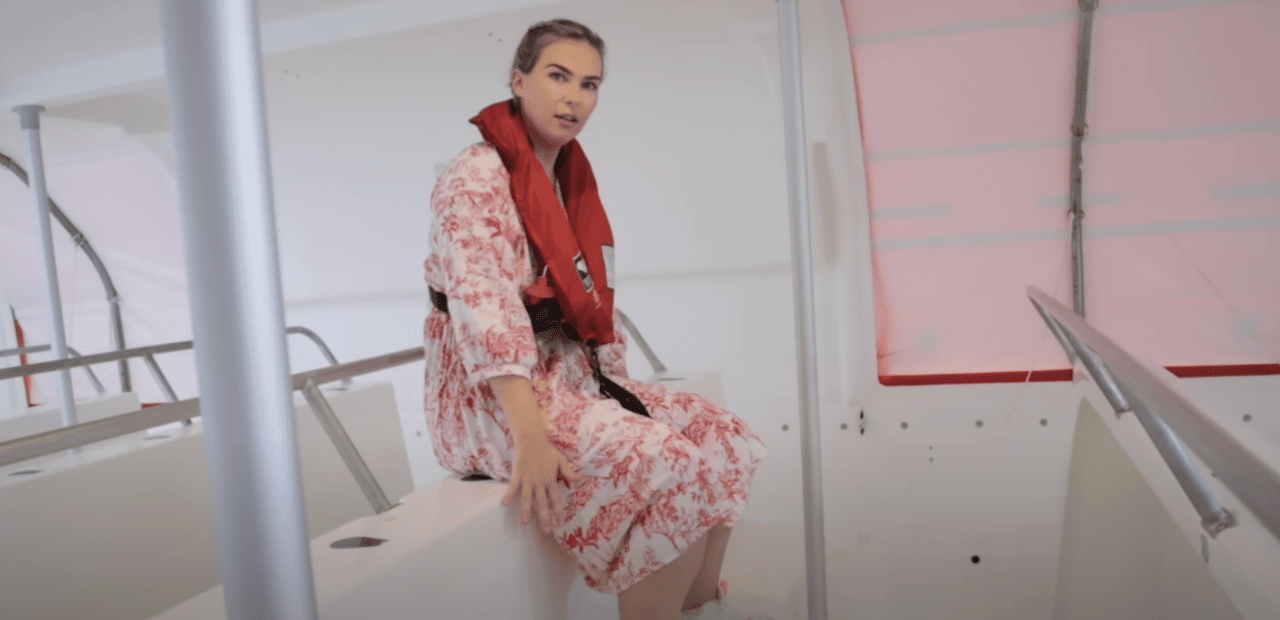
The second would be between their legs like this:
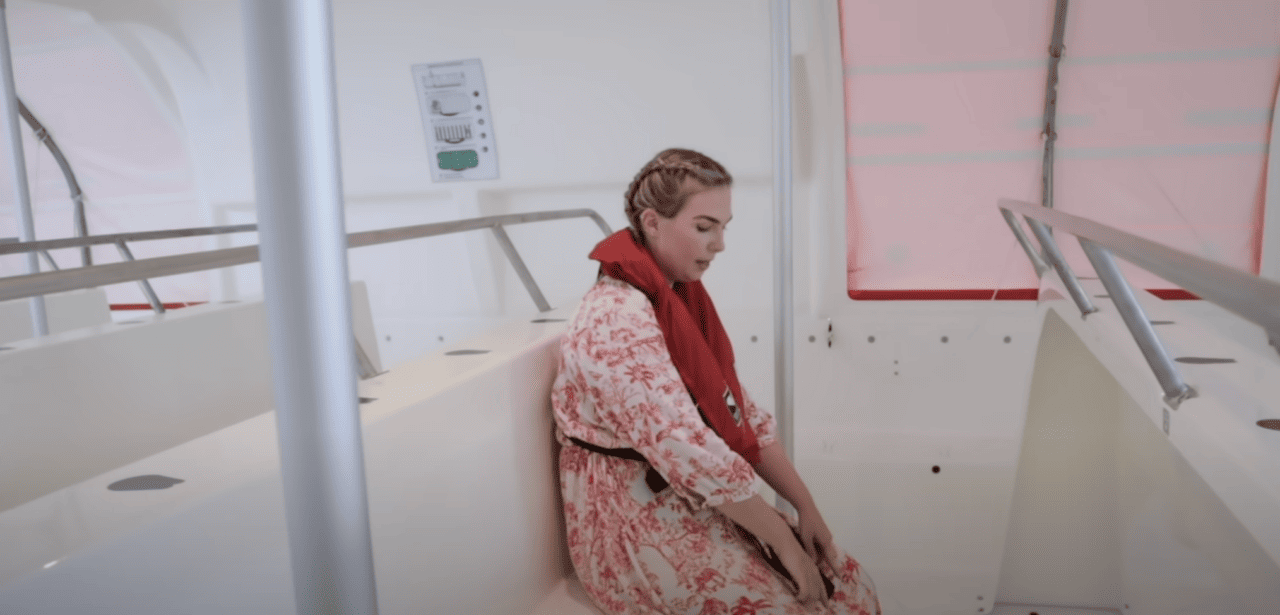
The third layer would be at the bottom between these peoples legs:

The below chart shows how the lifeboat would look at full capacity.
There are 14 crew members onboard each lifeboat seated between the passengers.
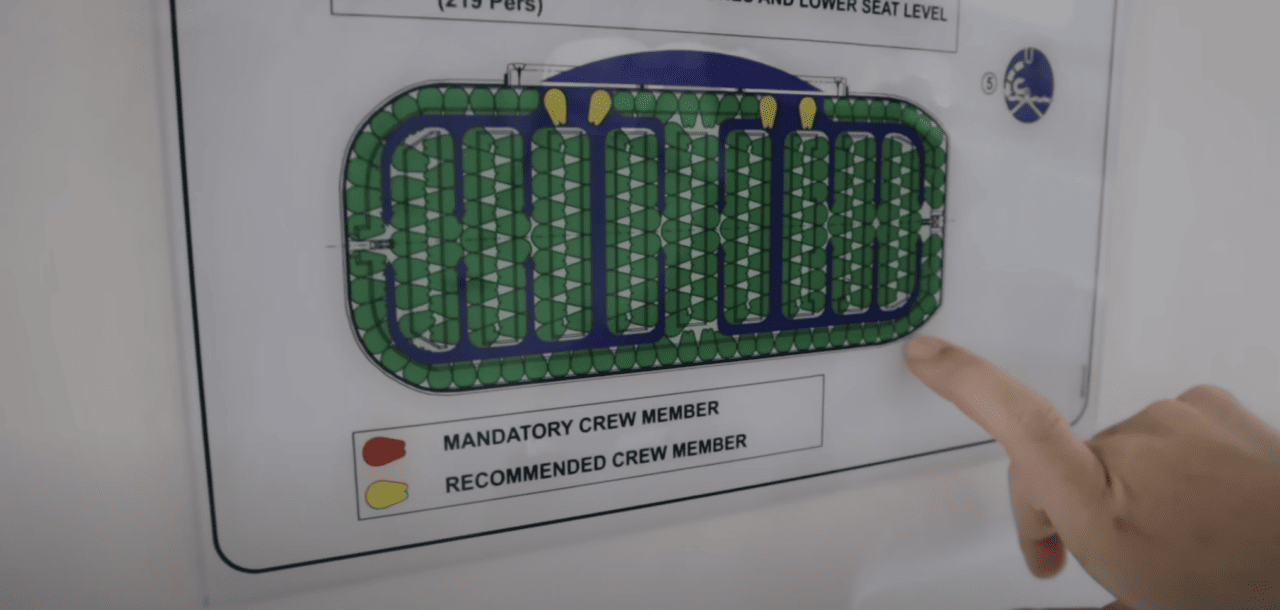
How Much Water is Onboard Cruise Ship Lifeboats?
Water is stored on the lifeboat in 500ml packets and there are 6 onboard per guest meaning that each passenger has 3 litres of water onboard.
Each packet is meant to last a passenger one day meaning that the lifeboat would have enough water onboard to last for a week.
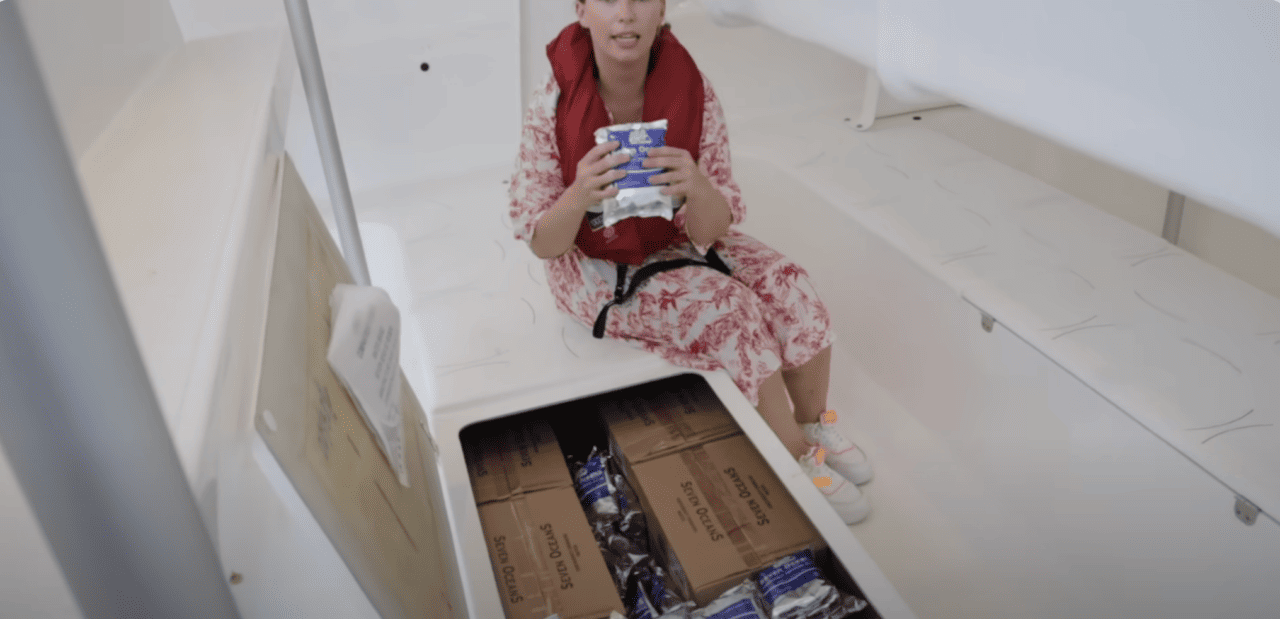
There are multiple water storage boxes on the lifeboat and the guests would have to all move around (as much as possible) so that the crew could access the water.

There are no toilets onboard but there are some plastic bedpan-style tubs that would be used with the waste being thrown overboard.
How Much Food is Onboard a Lifeboat?
Every guest on a lifeboat is assigned one week’s worth of food in the form of high-calorie biscuits. There are 9 biscuits in the box and 271 calories per biscuit.
You definitely would be hungry on that diet but it’s enough to keep you alive.

What Life-Saving Equipment is in a Lifeboat?
Inside a cruise ship lifeboat you will find:
- Fishing tackle
- Torches/flashlights and batteries
- Signals for rescue: Smoke floats, rockets, and hand flares are all onboard to signal for help

The smoke float seen above is released and it’ll create a large amount of orange smoke, the idea being that it may be seen by a passing ship or aircraft.
The hand flares burn for around a minute.
- A can opener
- A sea anchor (used to slow a lifeboat down or stay in a certain position)
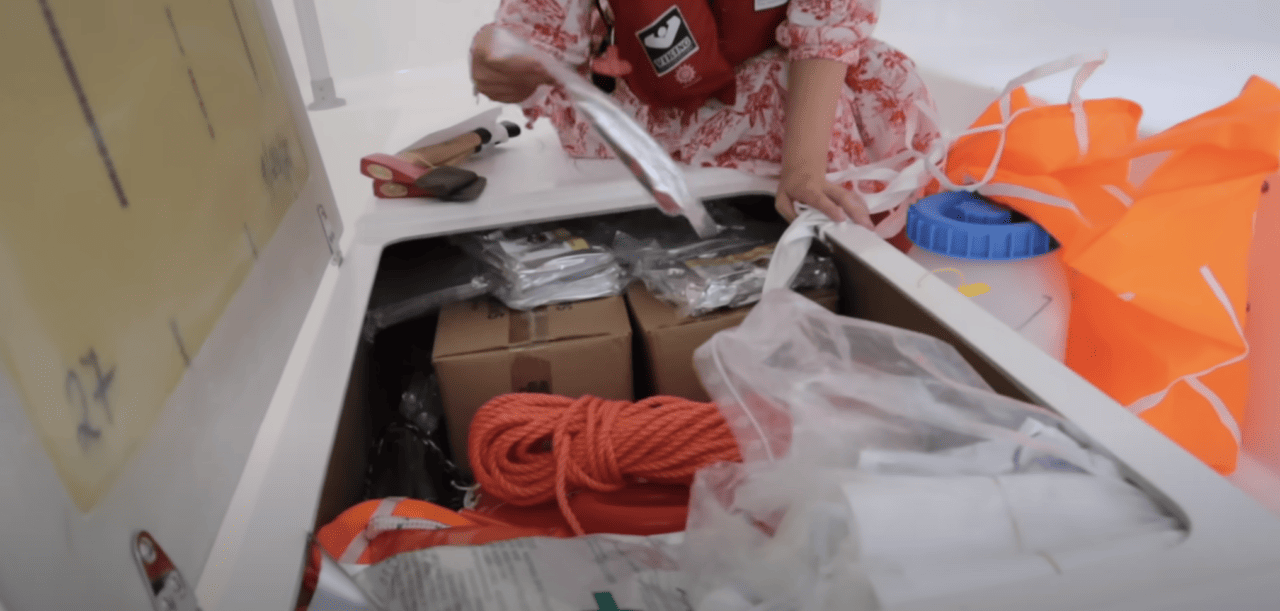
- Thermal protective blankets, in case anybody gets wet/cold (every ship has to have these for 10% of the lifeboats capacity)
Lifeboats also have seasickness bags and seasickness tablets onboard. Guests will be given a seasickness pill as they enter the lifeboat for the first time unless there is a medical reason why they can’t have one.
- Multiple first aid kits
- Rope ladder
- Screw and spare parts
Where Do You Drive a Lifeboat From?
The driver’s seat on a lifeboat is up high and does require climbing up a lot of the seats. On some lifeboats, the driver’s seat area will stick up and out slightly.
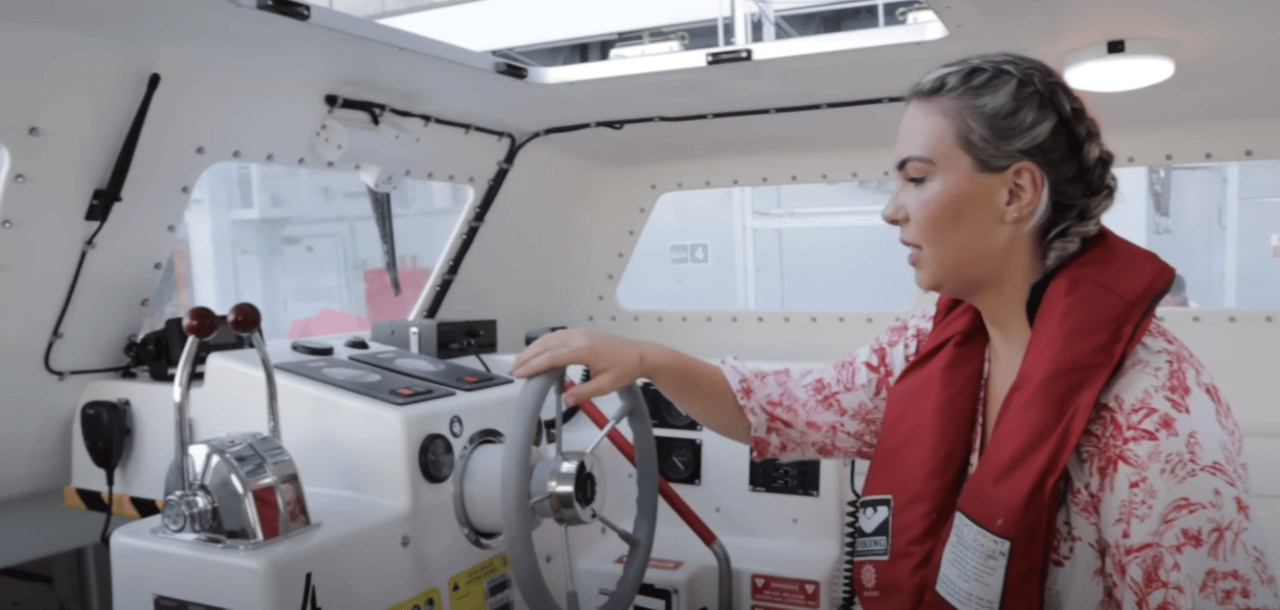
The lifeboats have two engines, port and starboard.
They have communication tools for speaking to other ships and an internal PA system for making announcements.
Next to the steering wheel are the fuel gauges and release hook which is a safety device that is used so the lifeboat can detatch itself from the ship.
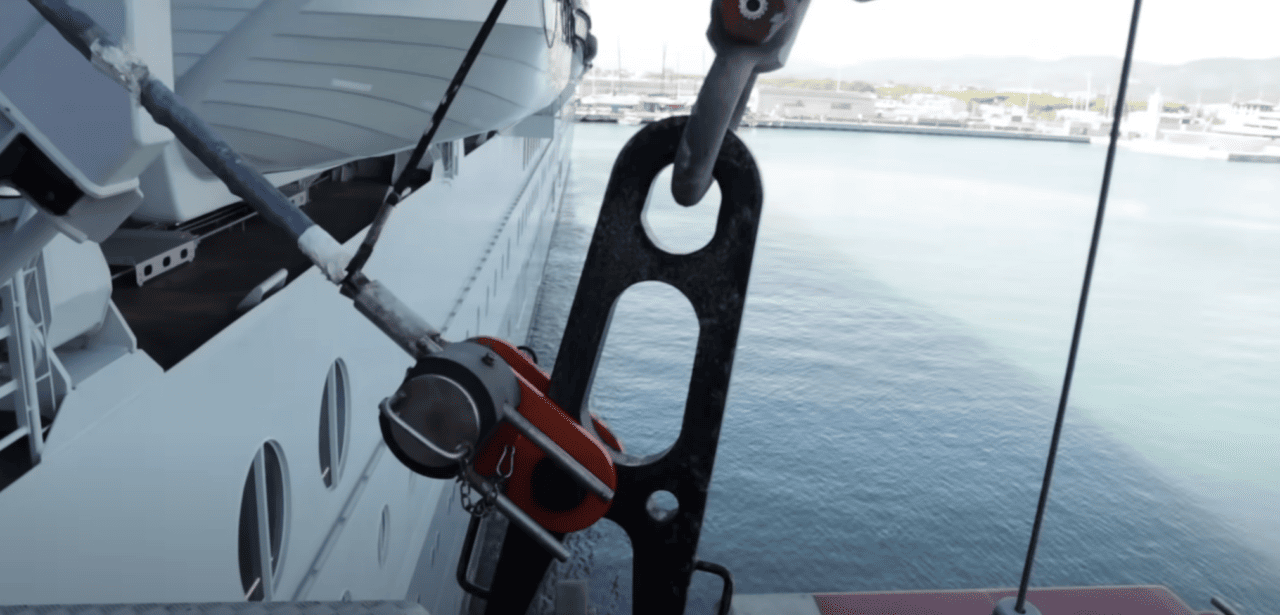
The lifeboat also has ventilation and window wipers.

Fire Extinguishers Are Fitted Directly Into The Engines
Realistically the only thing that would catch on fire in a lifeboat is the engines so the fire extinguishers are fitted here.
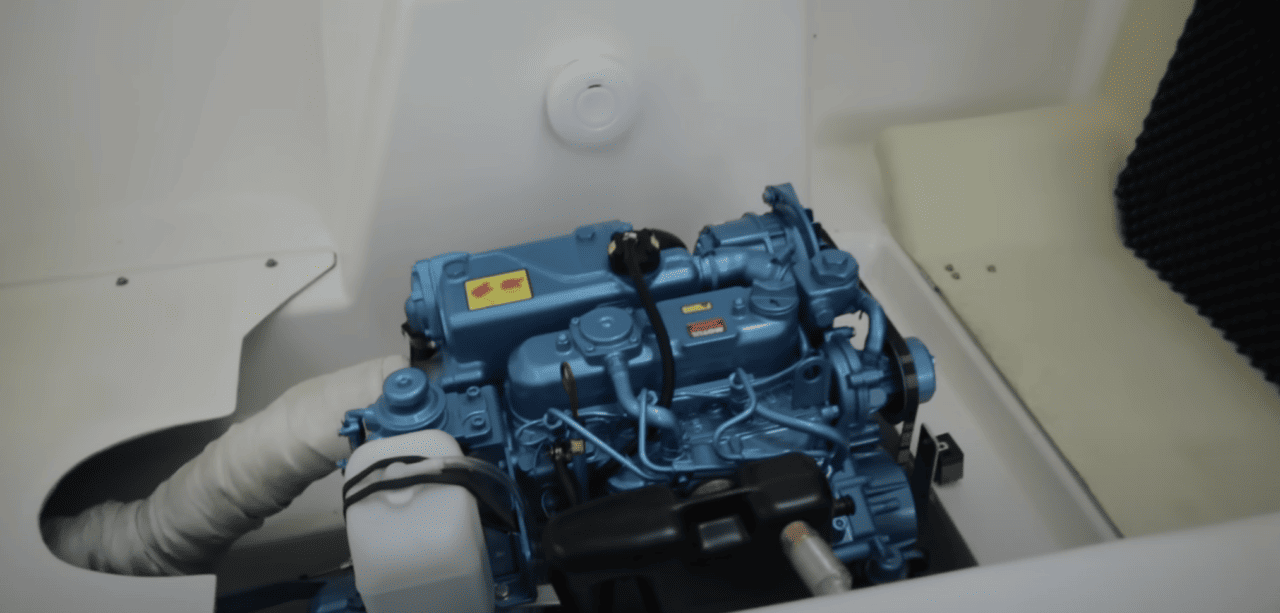
This means that it would be able to extinguish a fire without fogging up the entire lifeboat with all the guests on it.
The fire extinguishers are in the white box in the image below.
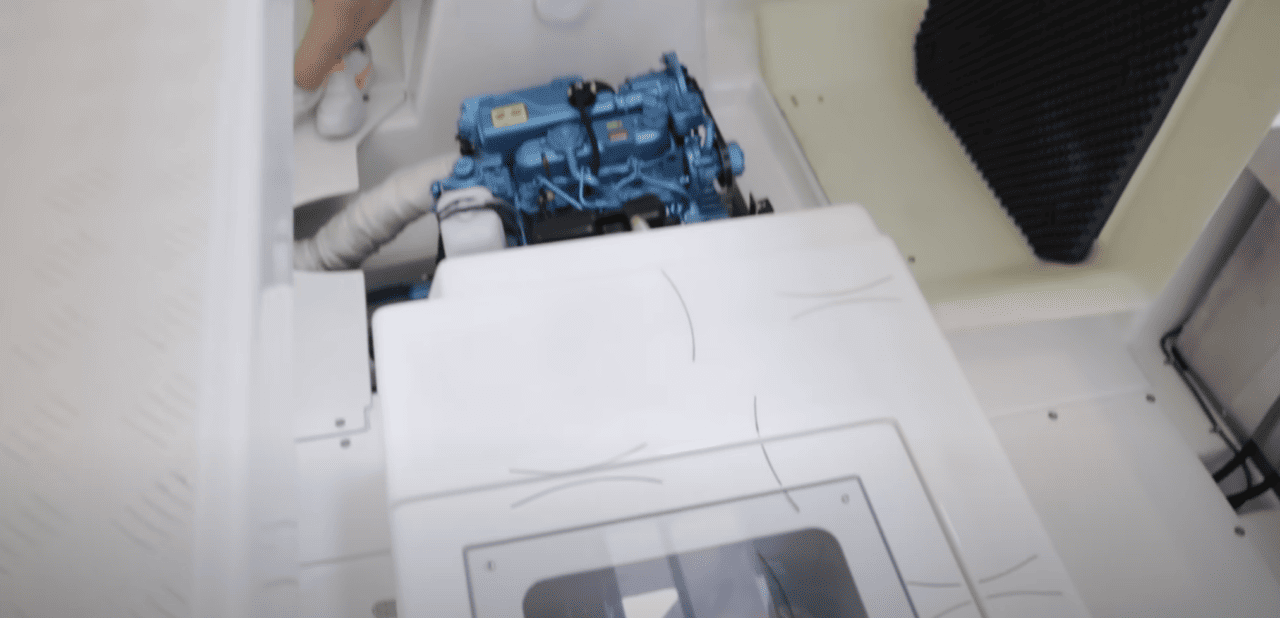
The lifeboat has four batteries onboard that power everything, including lights so that the lifeboat isn’t pitch black in the middle of the night.

The Cruise Ship May Tilt
By law, the cruise ship has to be able to launch its lifeboats even if the ship is leaning 20 degrees in either direction.
There are markers by the ship which shows how far the ship is leaning, if at all.
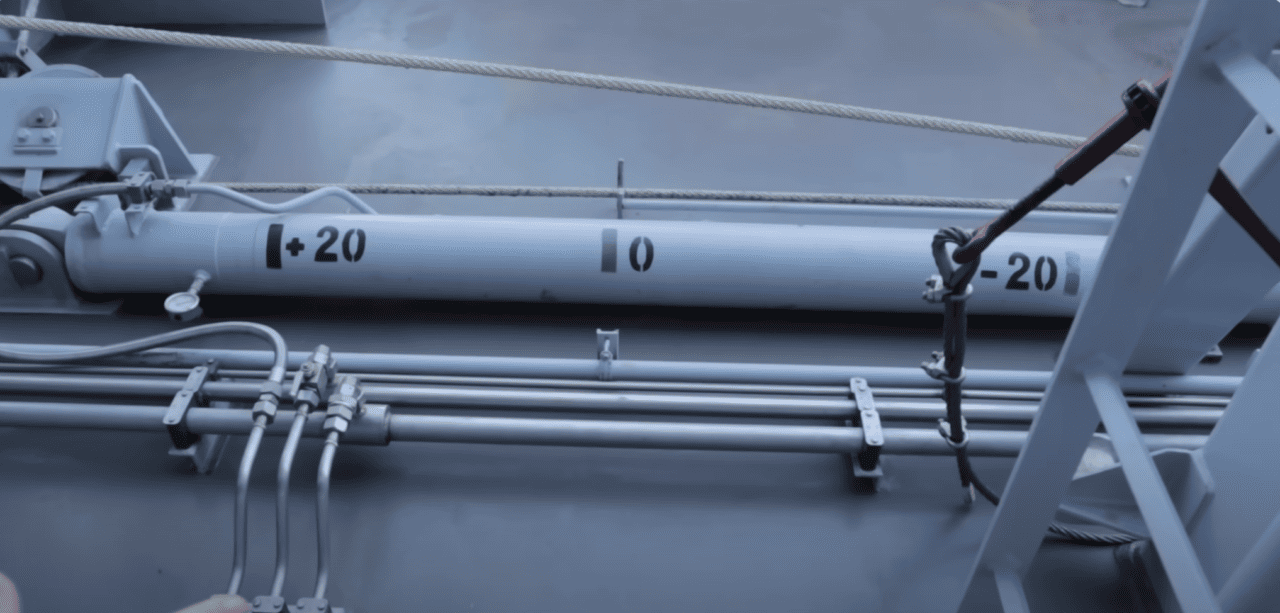
In 2012 a ship called the Costa Concordia hit a rock formation on the sea floor when the captain decided to go off route, initially the ship listed at 20 degrees before eventually dropping to 70.
33 people died in the disaster and Francesco Schettino was convicted on Manslaugher. He is still in prison and you can read more about that here: What Happened to The Captain of The Costa Concordia? – Conviction and Sentence
Check out Lucy’s full video here:

Free Insiders Cruise Line Guide
Enter your email address below:

Engineering Department Onboard Cruise Ships – A Detailed Guide
What comes to mind when we hear the word “ Cruise Ship ”?
Big, behemoth and beautiful seagoing vessels which resemble floating hotels, giant casinos, or floating theme parks?
Well, as glamorous as they may seem from the outside, a lot of discipline, punctuality & hard work goes into providing a unique experience of luxury, quality, comfort, fun, relaxation, safety & security for guests vacationing on them.
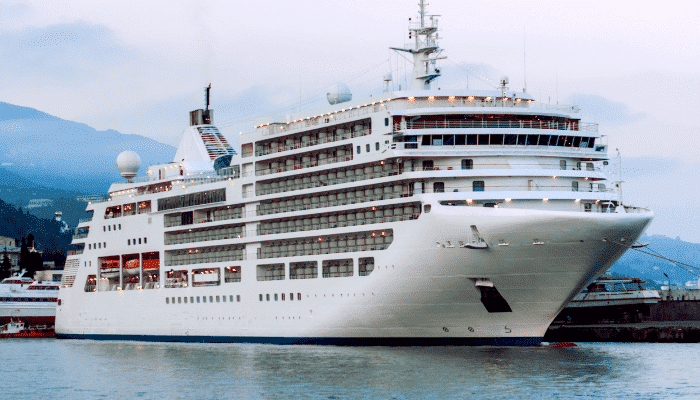
Many crew members work long shifts, putting in hours of hard work along with dedication, efficiency and attention to detail to ensure that guest needs are attended to as quickly as possible and that they only have the best experiences and the happiest memories of their limited time onboard.
An average-sized cruise ship typically has a passenger capacity of around 2000-2500 and a crew complement of 600-1000, which is predominantly divided amongst the following departments, viz., Deck, Engineering, Food & Beverage, Housekeeping, Sanitation, Guest Services, Laundry, Spa, Medical, Entertainment, Photography, Merchandise, IT, HR, Shore Excursions , Cruise Staff and Youth/Children’s activities.
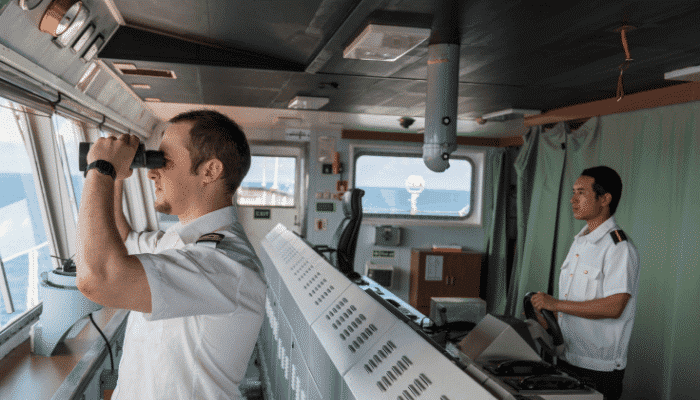
Let me give a brief introduction of the roles and responsibilities of the various departments on board.
The Deck department is headed by the captain and has command of the ship. Safety, Security and Environmental departments also come under their purview.
They are also responsible for drills related to safety, security, pollution prevention and also related shipboard training of the crew-members.
In some companies, the carpentry and upholstery department also come under the Deck department.
The food and Beverage department , as the name suggests comprises everything that is food-related or culinary in nature. All the restaurants, galleys, chefs, stewards, bakery and bar department come under it.
The housekeeping department takes care of the upkeep of the guest & officer cabins and public spaces onboard whereas the sanitation department ensures that all the shipboard areas are sanitized and germ/infection-free.
The laundry department handles the clothes and linen of the entire ship and the Spa department offers personal care, grooming and wellness services for the passengers. In many cruise lines, these can also be availed by senior officers.
Food and Beverage, Housekeeping, Sanitation, Laundry and Spa all have their assigned managers who report to the Hotel Director, who is the overall in charge of all Hotel operations, of which these departments are part.
Entertainment, Photography, Merchandise, Shore Excursions, Guest Services, Cruise staff and Youth/Children’s activities departments come under the purview of the Cruise Director.
While Entertainment is responsible for casinos, stage shows, theatre screenings, stage & theatre technicians and equipment, the Photography department, as the name suggests, helps the guests to capture their precious moments onboard as photographs and make lasting memories through them with family & friends, while enjoying various activities and events.
The merchandise department is in charge of all the retail shops onboard which sell exotic items and articles such as jewellery, goodies and memorabilia to guests. They also run crew shops onboard which sell articles of everyday use and utility to crew-members, such as toiletry items, medicines and snacks.
Shore Excursions department’s job is to make the shore-side trips of the guests to exotic destinations at various ports of call, as easy, fun, safe, adventure-filled, inexpensive and entertaining as possible.
Cruise staff focuses on fun activities, trivia, games & competitions for the guests and crew alike, whereas Youth and Children’s activities focus specifically on youth and children’s entertainment and even provides day-care services for children, especially toddlers.
The guest services department is the interface between the guests and the ship staff/crew. Their job is similar to the job of the hotel front desk or reception. Any service requests such as cabin service requests as well as complaints such as a leaky cabin faucet etc. are made by the guests through them.
It is their duty to take these requests and/or complaints and pass them on to the concerned departments for action/rectification, provide feedback to the guests and assist them with any further follow-ups if required.
All the above have their specific line managers who report to the Cruise Director. The roles and responsibilities of some departments though can vary slightly from company to company.
In addition to the above departments, Medical, Information Technology and Human Resource are independent departments who have their own heads and report directly to the captain and the company.
The Medical department typically has 3 to 4 doctors and a similar number of nurses who work in shifts. It is headed by a senior doctor. They cater to both passengers and crew requiring medical assistance, at separate timings during the day. They are also the first responders for any medical emergency onboard.
The Information Technology department is responsible for all the computers, servers, programming, LAN, Ethernet, Wi-Fi, related hardware and software on board. Any network-related maintenance and troubleshooting onboard are carried out by them.
The Human Resource department is responsible for the orientation and familiarization training of new employees. They are also responsible for crew training pertaining to company culture and tradition, policies, leadership skills and management. Any conflicts and complaints onboard, inter-departmental as well as intra-departmental, are handled by the HR department, in conjunction with other departments. Final decisions with regards to re-employment and termination of crew members are taken by the HR department, once again after consultation with other concerned departments.
The Engineering Department Of Cruise Ship

After a brief introduction to the roles and responsibilities of various departments onboard cruise ships, let us now focus on the main topic of our discussion in this article, the Engineering department , which covers all the technical & environmental operations of the vessel.
This department is headed by the Chief Engineer. The Staff Chief Engineer, Hotel Services Engineer, HVAC Engineer & the Chief Electrician, who are in charge of different engineering subdivisions, report to the Chief Engineer.
These subdivisions are – Main Plant & Environmental Engineering, Hotel Engineering, HVAC & Electrical/Electronics.
Let us look into each: –
Main Plant & Environmental Engineering
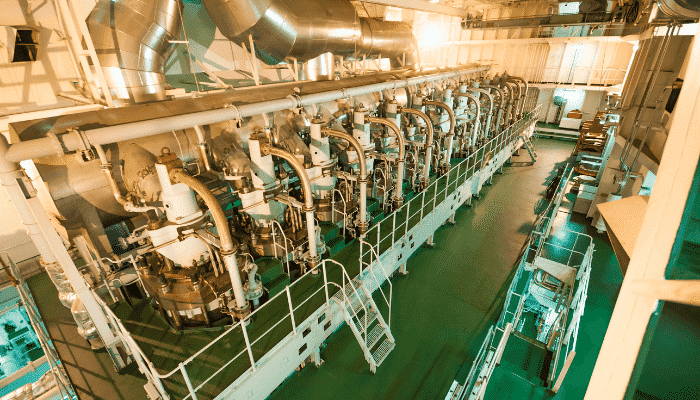
This subdivision is headed by the Staff Chief Engineer who, in turn, is subordinated by the senior watchkeepers (2nd Engineers), the First Engineer and the Environmental Engineer.
There are usually three watchkeeping teams, each headed by a senior watchkeeper and comprising of junior watchkeepers (3rd or 4th Engineers) and a motorman.
On cruise ships, there are thousands of guests on board at any given time and there could be guest complaints requiring the immediate attention of the technical department, at any time of the day or night, such as a vacuum toilet not working, a leaky shower or a broken sprinkler head etc.
The engine control room acts as not only a control centre for engine-room machinery but also as a communications centre where all the complaints/malfunctions or incidents related to technical equipment are communicated by other departments at any time as they occur.
In the above cases, it is the job of the senior watchkeepers who man the engine control room to attend such calls and communicate the concerns/complaints to the concerned in-charges, within the Engineering department.
Any hotel equipment related complaints, leaky cabin faucets or sprinkler heads, malfunctioning vacuum toilets to the Hotel department, any electrical equipment malfunctions to the Chief Electrical engineer and any AC/ ventilation related complaints to the HVAC engineer.
Therefore, unlike many cargo ships, the engine control room cannot at any moment, be left unmanned in UMS mode. The watchkeeping teams ensure that the engine room and the engine control room are manned 24 hours.
Each watchkeeping team also has certain assigned machinery under their responsibility. For example, one watch may be responsible for fuel oil system and purifiers, another may be assigned boiler & compressors, and the third may be in charge of freshwater generators and water treatment.
It is their responsibility to carry out maintenance as per PMS on their assigned equipment every day, in addition to their watchkeeping responsibilities.
This, in turn, is carried out ensuring that at no time the maintenance work affects the efficiency of watchkeeping duties. For any complicated maintenance requiring more time and manpower, they are provided assistance by the main plant team.
The First Engineer heads the main plant team and is the overall in-charge of engine-room machinery. He has a team of mechanics, fitters and wipers under him who help him in carrying out routine maintenance and overhauls of engine-room machinery.
All maintenance activities on the main diesel generators, engine-room pumps, heat exchangers, major repairs on boilers, preparation for boiler surveys, bunkering and any pipeline modifications/repairs within machinery spaces are handled by the main plant team.
The Environmental Engineer is responsible for the wastewater treatment plant and garbage-handling equipment and has designated motormen under him.
The sewage treatment plant and related pumps and equipment, black water units, screen presses, incinerators and food waste processing equipment come under his KRA.
Hotel Engineering
It is the name given to the subdivision of the Engineering department which deals with all the machinery that are not part of engine-room operations.
The Hotel Services Engineer helms it and is supported by assistant hotel service engineers, plumbers, fitters and a water technician.
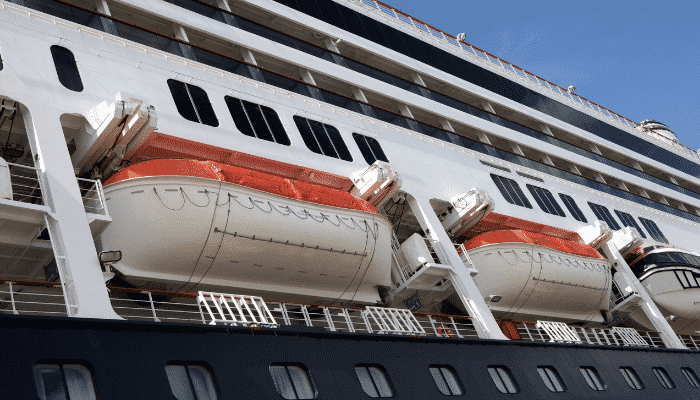
Their responsibilities include safety equipment such as lifeboats & davits, sprinkler system, hydraulic side-shell doors, watertight doors , vacuum toilets, freshwater distribution lines in the accommodation and hotel machinery such as coffee-makers, ice-cream vending machines etc.
They are also responsible for chlorination and maintenance of all the swimming pools on board and in some companies, also for potable water treatment and chlorination. This is handled exclusively by the water technician who reports to the Hotel services engineer.
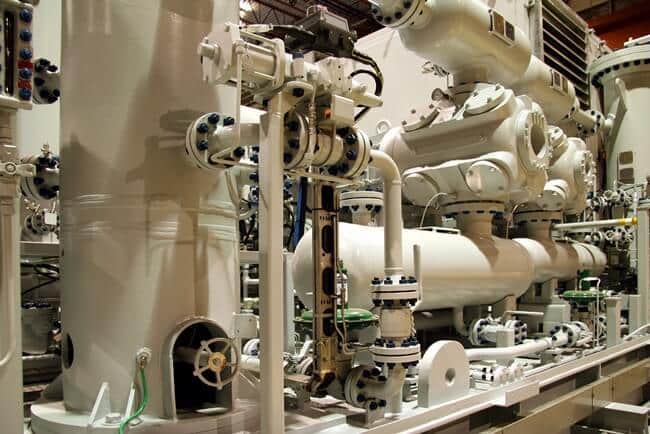
HVAC stands for Heating, Ventilation and Air-Conditioning. It is helmed by the Chief AC Engineer, and he, in turn, is assisted by Assistant AC Engineers, AC Technicians, fitters and wipers.
Their areas of responsibilities pertain to the operation and maintenance of the main AC Chillers, which provide air conditioning all over the ship, Air handling Units, Ventilation fans, Refrigeration Machinery, Cold rooms, Chilled & heated water system and related heat exchangers.
Electrical Department

It is helmed by the Chief Electrical Engineer, who is sub-ordinated by the First electrician, Electronics engineer, 2nd electricians and assistant electricians.
It is one department that has a large scope of work as electrical installations and equipment are everywhere on the ship, many of them requiring everyday checks and maintenance, both regular and breakdown.
Almost all passenger vessels have high voltage installations, mostly 6.6 kV or 11 kV. This is because, since current demand is high, a higher voltage is adopted so that conductor size, and consequently electrical losses, can be reduced.
The high voltage switchboards require special training and procedures, with regards to electrical safety, which cruise ship electricians are equipped and certified with.
They are also responsible for electrical propulsion systems, which propel most cruise ships, related transformers and converters.
Therefore, as we saw, from propelling the ship to wonderful destinations, providing power to the entire ship, maintaining passenger comfort and hygiene whilst ensuring that they have uninterrupted enjoyment onboard and complying strictly with safety and pollution prevention regulations, the diverse roles and responsibilities that the Engineering department takes up, makes them critical for cruise ship operations.
You might also like to read:
- Top 10 Most Expensive Cruise Ships in 2021
- A List of Unique and Interesting Marine Careers
- 50 Marine Careers Essential Guide
- What is Naval Architecture: Careers, Courses And Jobs For Naval Architects
- A Career in Logistics: A Detailed Guide
Disclaimer: The authors’ views expressed in this article do not necessarily reflect the views of Marine Insight. Data and charts, if used, in the article have been sourced from available information and have not been authenticated by any statutory authority. The author and Marine Insight do not claim it to be accurate nor accept any responsibility for the same. The views constitute only the opinions and do not constitute any guidelines or recommendations on any course of action to be followed by the reader.
Do you have info to share with us ? Suggest a correction

Related Posts
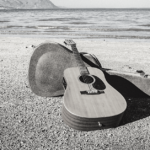
Subscribe To Our Newsletters
By subscribing, you agree to our Privacy Policy and may receive occasional deal communications; you can unsubscribe anytime.
Web Stories
Latest Life At Sea Articles You Would Like :
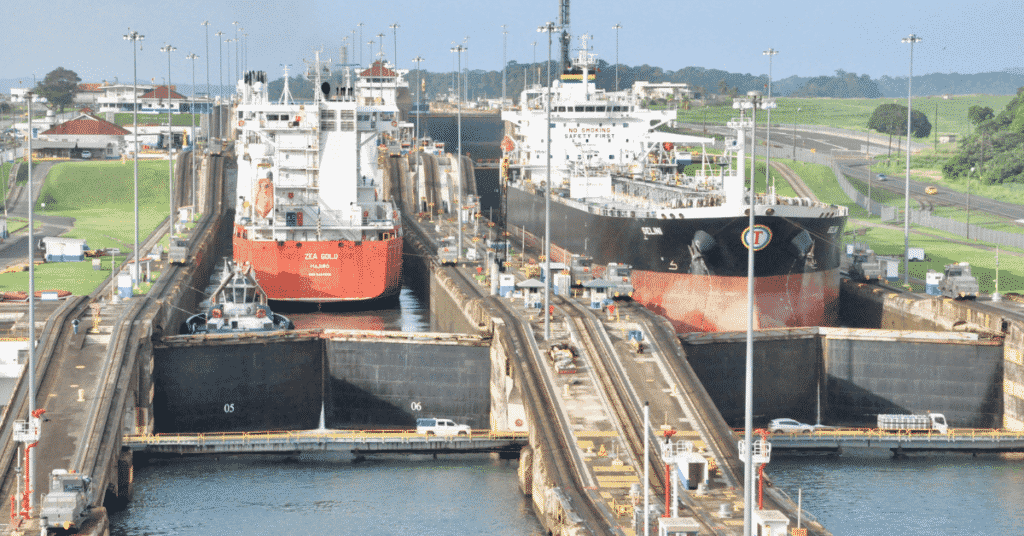
My First Journey Through The Panama Canal – 4th Engineer Describes His Experience
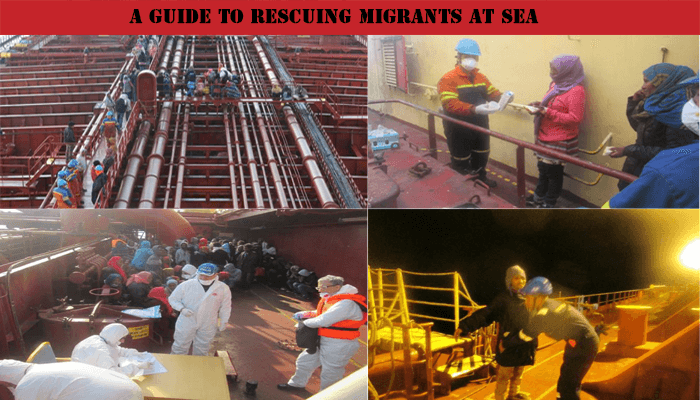
23 Points Guide For Merchant Ships To Rescue Migrants At Sea
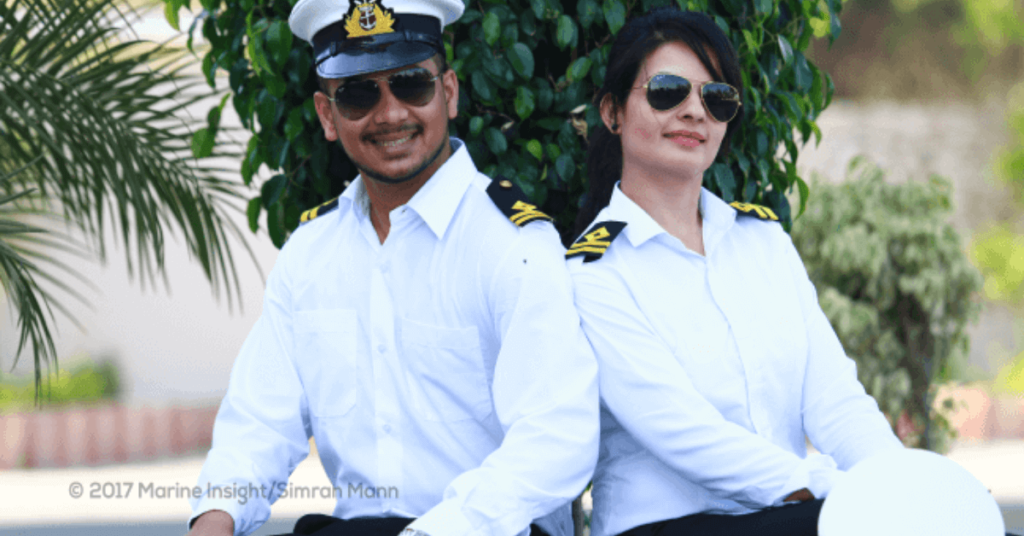
Sailor Couple: A Match Made At Sea
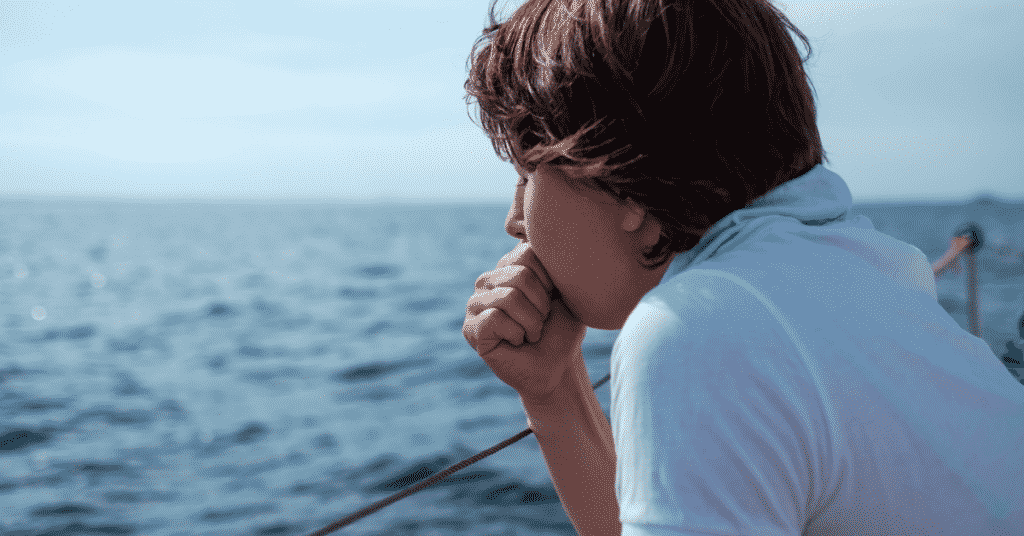
What is Seasickness And How to Tackle it?
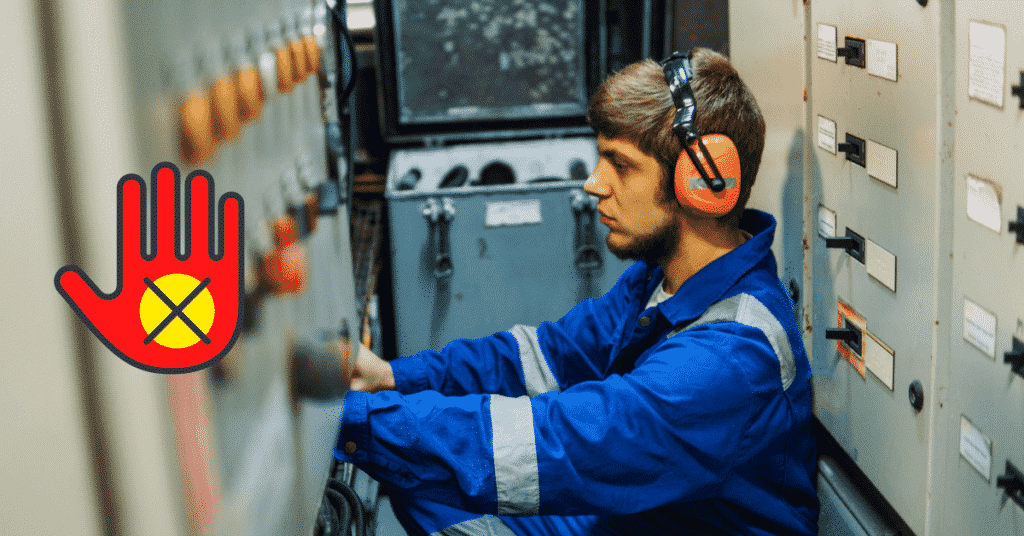
Top 14 Things a Junior/Trainee Marine Engineer Shouldn’t Do When New to Ship
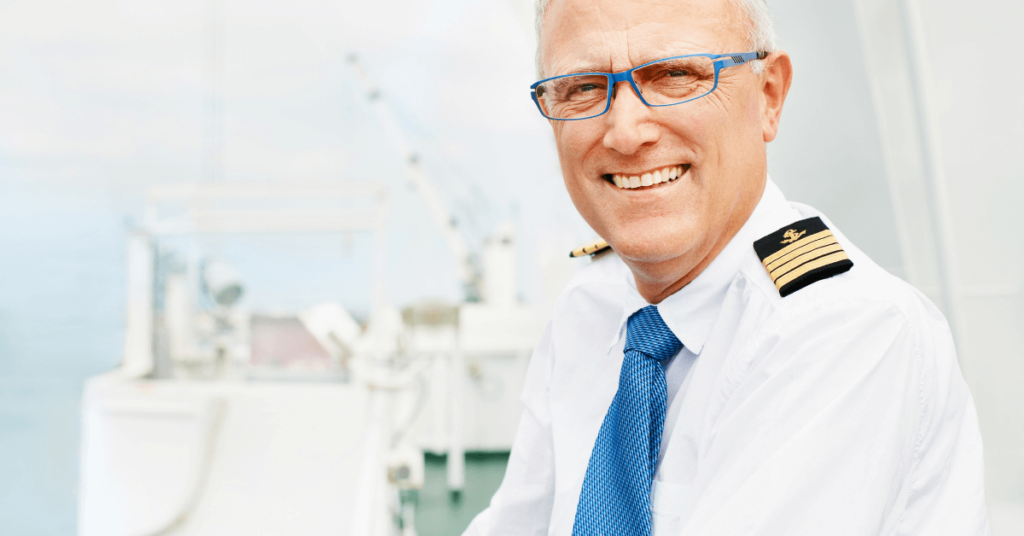
Interview: Master Mariners Speak On Training, Corruption And Jobs In the Industry Today
Leave a reply.
Your email address will not be published. Required fields are marked *
Subscribe to Marine Insight Daily Newsletter
" * " indicates required fields
Marine Engineering
Marine Engine Air Compressor Marine Boiler Oily Water Separator Marine Electrical Ship Generator Ship Stabilizer
Nautical Science
Mooring Bridge Watchkeeping Ship Manoeuvring Nautical Charts Anchoring Nautical Equipment Shipboard Guidelines
Explore
Free Maritime eBooks Premium Maritime eBooks Marine Safety Financial Planning Marine Careers Maritime Law Ship Dry Dock
Shipping News Maritime Reports Videos Maritime Piracy Offshore Safety Of Life At Sea (SOLAS) MARPOL
- First Time Cruisers
How noisey are the engines?
By hopefrog , September 7, 2012 in First Time Cruisers
Recommended Posts

I have read alot that the engines are noisey on the lower deck aft. Is it a steady noise like a fan? If it is this would be better than other outside noise. We are used to sleeping with a loud fan. Anyone know?
Link to comment
Share on other sites.

The quietness is one of the first things that I noticed when we were on our first cruise this summer. I did expect some low background noise from the engines, but if it was there, it was at a very low level (and this was on a 20-year old ship, which is likely noisier than newer ships).
As a matter of fact, I'd say that the background noise of the engines seemed quietier than the background noise of an average house at night.

You don't hear engine noise, but if you are forward or aft you might hear noise and vibration from the thrusters when docking or leaving port. EM

Cruise ships are generally powered by multiple engines which drive generators to make electricity to drive motors that are connected to the props. Because the engines are very heavy they are located amid ships on the lowest deck. The electric motors that drive the props are either located further aft on the same deck of below the ship in Azipods (which are located towards the aft end). So the cabins located on lower decks amidships are the most likely to hear any engine noise (rare these days) and feel any vibration from those engines. The cabins aft are the most likely to experience vibration which is usually caused by cavitation of the props. The quietest cabins are often located towards the bow....but many don;t like these cabins because they experience the most motion in rough seas. So take your choice :)
We actually love cabins towards the bow because it is much quieter. On ships where we can feel the thrusters this is normally a good thing since it only wakes us when the ship is docking (time to get up) or lets us know when the ship is leaving. As to the motion, DW and I love the feel of a moving ship and when its rough the motion simply rocks us asleep :)
.thumb.jpg.f2e8609bf828f46e237abee0ba9132a2.jpg)
You shouldn't hear much in the way of noise so I would not worry about it.

You won't hear any engine noise.....a ship is not like an airplane or car!

The only noise I have ever heard on a lower forward deck is the noise of the anchor being raised or lowered.~Doris~

You might, as has been said, feel some vibration on a lower deck aft, but you are unlikely to hear the engines themselves. They are generally separated from guest cabin decks by at least one deck, if not more. If you are closer to the bow or stern, you will feel the thrusters when going in and out of port, and (particularly forward) you will hear the windlasses used for the anchors or dock lines.
Yes, you will likely feel more vibration.
Vampire Parrot
The diesel engines are extremely loud. Ear protection is mandatory for anyone in either of the engine rooms. :rolleyes: :)
But only the excellent people who keep them running really hear them.... you won't hear the diesels at all. You may feel slight vibration from the propellers (or azipods), and when mooring and unmooring you may feel momentary vibration from the bow (and stern) thrusters.
The only two times I've really noticed vibration on Arcadia (an azipod ship) were -
1) When there was a problem with the azipods, quickly fixed by the engineers, and
2) When Arcadia was doing a speed trial to determine maximum speed, maximum power/RPM to the pods (limits 17.6MW / 146rpm), and she achieved a constant 24.5 knots. Pretty fast for a cruise ship, but she was then drinking fuel faster than the passengers were drinking beer and wine.
Personally I like to feel a ship move.... it's one of the best things about being at sea!

Most times the 'noise' we hear are bands playing too loudly. :D
Sometimes I think I'd rather loud engines to horridly too loud music. :)
You should not be bothered with engine noises but an understandable question to ask. IMO
forwardcabin
What engines? Thought the ship moved slowly because it was pushed by the wind!

The diesel engines are extremely loud. Ear protection is mandatory for anyone in either of the engine rooms. :rolleyes: :) VP
I was fortunate to be one of 12 that got to stand beside the engines on an Engine Room tour of the Ms Oosterdam. We wore no hearing protection and could carry on a conversation without shouting.
This is my only reference to ship noise. Now the propellers turning in the water can produce some noise but that just makes for a truly sound sleep.
As stated earlier, the thrusters used to move the ship while docking can be noisy but only for the few minutes that they are used.
You hear many things on a ship. However, you also feel the motion. You can feel the ship cut the waves. You can hear the bow break each wave. You can feel the pulse of the engines and props. You hear and feel the bow thrusters but that signals docking. It is time to get moving.
I like the motion as it reminds me I am on a ship. It often looks like a hotel or resort, but it is that and more. My 'hotel' is moving to a new place tomorrow and ever bow wave is closer to the next adventure.
Depending on your cabin and ship, you will hear and feel the ship. It is not only minor for me but part of the special effect of cruising. I hope you can enjoy what is special about it.
This topic is now archived and is closed to further replies.
- Welcome to Cruise Critic
- ANNOUNCEMENT: Set Sail Beyond the Ordinary with Oceania Cruises
- New Cruisers
- Cruise Lines “A – O”
- Cruise Lines “P – Z”
- River Cruising
- Cruise Critic News & Features
- Digital Photography & Cruise Technology
- Special Interest Cruising
- Cruise Discussion Topics
- UK Cruising
- Australia & New Zealand Cruisers
- Canadian Cruisers
- North American Homeports
- Ports of Call
- Cruise Conversations
Announcements
- New to Cruise Critic? Join our Community!
Write Your Own Amazing Review !

Click this gorgeous photo by member SUPERstar777 to share your review!
Features & News

LauraS · Started 11 hours ago
LauraS · Started Yesterday at 12:53 AM
LauraS · Started Tuesday at 07:17 PM
LauraS · Started Monday at 10:08 PM
LauraS · Started Monday at 09:45 PM

- Existing user? Sign in OR Create an Account
- Find Your Roll Call
- Meet & Mingle
- Community Help Center
- All Activity
- Member Photo Albums
- Meet & Mingle Photos
- Favorite Cruise Memories
- Cruise Food Photos
- Cruise Ship Photos
- Ports of Call Photos
- Towel Animal Photos
- Amazing, Funny & Totally Awesome Cruise Photos
- Write a Review
- Live Cruise Reports
- Member Cruise Reviews
- Create New...

Crying Myself to Sleep on the Biggest Cruise Ship Ever
Seven agonizing nights aboard the Icon of the Seas

Listen to this article
Listen to more stories on curio
Updated at 2:44 p.m. ET on April 6, 2024.
This article was featured in the One Story to Read Today newsletter. Sign up for it here .
MY FIRST GLIMPSE of Royal Caribbean’s Icon of the Seas, from the window of an approaching Miami cab, brings on a feeling of vertigo, nausea, amazement, and distress. I shut my eyes in defense, as my brain tells my optic nerve to try again.
The ship makes no sense, vertically or horizontally. It makes no sense on sea, or on land, or in outer space. It looks like a hodgepodge of domes and minarets, tubes and canopies, like Istanbul had it been designed by idiots. Vibrant, oversignifying colors are stacked upon other such colors, decks perched over still more decks; the only comfort is a row of lifeboats ringing its perimeter. There is no imposed order, no cogent thought, and, for those who do not harbor a totalitarian sense of gigantomania, no visual mercy. This is the biggest cruise ship ever built, and I have been tasked with witnessing its inaugural voyage.
Explore the May 2024 Issue
Check out more from this issue and find your next story to read.
“Author embarks on their first cruise-ship voyage” has been a staple of American essay writing for almost three decades, beginning with David Foster Wallace’s “A Supposedly Fun Thing I’ll Never Do Again,” which was first published in 1996 under the title “Shipping Out.” Since then, many admirable writers have widened and diversified the genre. Usually the essayist commissioned to take to the sea is in their first or second flush of youth and is ready to sharpen their wit against the hull of the offending vessel. I am 51, old and tired, having seen much of the world as a former travel journalist, and mostly what I do in both life and prose is shrug while muttering to my imaginary dachshund, “This too shall pass.” But the Icon of the Seas will not countenance a shrug. The Icon of the Seas is the Linda Loman of cruise ships, exclaiming that attention must be paid. And here I am in late January with my one piece of luggage and useless gray winter jacket and passport, zipping through the Port of Miami en route to the gangway that will separate me from the bulk of North America for more than seven days, ready to pay it in full.
The aforementioned gangway opens up directly onto a thriving mall (I will soon learn it is imperiously called the “Royal Promenade”), presently filled with yapping passengers beneath a ceiling studded with balloons ready to drop. Crew members from every part of the global South, as well as a few Balkans, are shepherding us along while pressing flutes of champagne into our hands. By a humming Starbucks, I drink as many of these as I can and prepare to find my cabin. I show my blue Suite Sky SeaPass Card (more on this later, much more) to a smiling woman from the Philippines, and she tells me to go “aft.” Which is where, now? As someone who has rarely sailed on a vessel grander than the Staten Island Ferry, I am confused. It turns out that the aft is the stern of the ship, or, for those of us who don’t know what a stern or an aft are, its ass. The nose of the ship, responsible for separating the waves before it, is also called a bow, and is marked for passengers as the FWD , or forward. The part of the contemporary sailing vessel where the malls are clustered is called the midship. I trust that you have enjoyed this nautical lesson.
I ascend via elevator to my suite on Deck 11. This is where I encounter my first terrible surprise. My suite windows and balcony do not face the ocean. Instead, they look out onto another shopping mall. This mall is the one that’s called Central Park, perhaps in homage to the Olmsted-designed bit of greenery in the middle of my hometown. Although on land I would be delighted to own a suite with Central Park views, here I am deeply depressed. To sail on a ship and not wake up to a vast blue carpet of ocean? Unthinkable.
Allow me a brief preamble here. The story you are reading was commissioned at a moment when most staterooms on the Icon were sold out. In fact, so enthralled by the prospect of this voyage were hard-core mariners that the ship’s entire inventory of guest rooms (the Icon can accommodate up to 7,600 passengers, but its inaugural journey was reduced to 5,000 or so for a less crowded experience) was almost immediately sold out. Hence, this publication was faced with the shocking prospect of paying nearly $19,000 to procure for this solitary passenger an entire suite—not including drinking expenses—all for the privilege of bringing you this article. But the suite in question doesn’t even have a view of the ocean! I sit down hard on my soft bed. Nineteen thousand dollars for this .

The viewless suite does have its pluses. In addition to all the Malin+Goetz products in my dual bathrooms, I am granted use of a dedicated Suite Deck lounge; access to Coastal Kitchen, a superior restaurant for Suites passengers; complimentary VOOM SM Surf & Stream (“the fastest Internet at Sea”) “for one device per person for the whole cruise duration”; a pair of bathrobes (one of which comes prestained with what looks like a large expectoration by the greenest lizard on Earth); and use of the Grove Suite Sun, an area on Decks 18 and 19 with food and deck chairs reserved exclusively for Suite passengers. I also get reserved seating for a performance of The Wizard of Oz , an ice-skating tribute to the periodic table, and similar provocations. The very color of my Suite Sky SeaPass Card, an oceanic blue as opposed to the cloying royal purple of the standard non-Suite passenger, will soon provoke envy and admiration. But as high as my status may be, there are those on board who have much higher status still, and I will soon learn to bow before them.
In preparation for sailing, I have “priced in,” as they say on Wall Street, the possibility that I may come from a somewhat different monde than many of the other cruisers. Without falling into stereotypes or preconceptions, I prepare myself for a friendly outspokenness on the part of my fellow seafarers that may not comply with modern DEI standards. I believe in meeting people halfway, and so the day before flying down to Miami, I visited what remains of Little Italy to purchase a popular T-shirt that reads DADDY’S LITTLE MEATBALL across the breast in the colors of the Italian flag. My wife recommended that I bring one of my many T-shirts featuring Snoopy and the Peanuts gang, as all Americans love the beagle and his friends. But I naively thought that my meatball T-shirt would be more suitable for conversation-starting. “Oh, and who is your ‘daddy’?” some might ask upon seeing it. “And how long have you been his ‘little meatball’?” And so on.
I put on my meatball T-shirt and head for one of the dining rooms to get a late lunch. In the elevator, I stick out my chest for all to read the funny legend upon it, but soon I realize that despite its burnished tricolor letters, no one takes note. More to the point, no one takes note of me. Despite my attempts at bridge building, the very sight of me (small, ethnic, without a cap bearing the name of a football team) elicits no reaction from other passengers. Most often, they will small-talk over me as if I don’t exist. This brings to mind the travails of David Foster Wallace , who felt so ostracized by his fellow passengers that he retreated to his cabin for much of his voyage. And Wallace was raised primarily in the Midwest and was a much larger, more American-looking meatball than I am. If he couldn’t talk to these people, how will I? What if I leave this ship without making any friends at all, despite my T-shirt? I am a social creature, and the prospect of seven days alone and apart is saddening. Wallace’s stateroom, at least, had a view of the ocean, a kind of cheap eternity.
Worse awaits me in the dining room. This is a large, multichandeliered room where I attended my safety training (I was shown how to put on a flotation vest; it is a very simple procedure). But the maître d’ politely refuses me entry in an English that seems to verge on another language. “I’m sorry, this is only for pendejos ,” he seems to be saying. I push back politely and he repeats himself. Pendejos ? Piranhas? There’s some kind of P-word to which I am not attuned. Meanwhile elderly passengers stream right past, powered by their limbs, walkers, and electric wheelchairs. “It is only pendejo dining today, sir.” “But I have a suite!” I say, already starting to catch on to the ship’s class system. He examines my card again. “But you are not a pendejo ,” he confirms. I am wearing a DADDY’S LITTLE MEATBALL T-shirt, I want to say to him. I am the essence of pendejo .
Eventually, I give up and head to the plebeian buffet on Deck 15, which has an aquatic-styled name I have now forgotten. Before gaining entry to this endless cornucopia of reheated food, one passes a washing station of many sinks and soap dispensers, and perhaps the most intriguing character on the entire ship. He is Mr. Washy Washy—or, according to his name tag, Nielbert of the Philippines—and he is dressed as a taco (on other occasions, I’ll see him dressed as a burger). Mr. Washy Washy performs an eponymous song in spirited, indeed flamboyant English: “Washy, washy, wash your hands, WASHY WASHY!” The dangers of norovirus and COVID on a cruise ship this size (a giant fellow ship was stricken with the former right after my voyage) makes Mr. Washy Washy an essential member of the crew. The problem lies with the food at the end of Washy’s rainbow. The buffet is groaning with what sounds like sophisticated dishes—marinated octopus, boiled egg with anchovy, chorizo, lobster claws—but every animal tastes tragically the same, as if there was only one creature available at the market, a “cruisipus” bred specifically for Royal Caribbean dining. The “vegetables” are no better. I pick up a tomato slice and look right through it. It tastes like cellophane. I sit alone, apart from the couples and parents with gaggles of children, as “We Are Family” echoes across the buffet space.
I may have failed to mention that all this time, the Icon of the Seas has not left port. As the fiery mango of the subtropical setting sun makes Miami’s condo skyline even more apocalyptic, the ship shoves off beneath a perfunctory display of fireworks. After the sun sets, in the far, dark distance, another circus-lit cruise ship ruptures the waves before us. We glance at it with pity, because it is by definition a smaller ship than our own. I am on Deck 15, outside the buffet and overlooking a bunch of pools (the Icon has seven of them), drinking a frilly drink that I got from one of the bars (the Icon has 15 of them), still too shy to speak to anyone, despite Sister Sledge’s assertion that all on the ship are somehow related.
Kim Brooks: On failing the family vacation
The ship’s passage away from Ron DeSantis’s Florida provides no frisson, no sense of developing “sea legs,” as the ship is too large to register the presence of waves unless a mighty wind adds significant chop. It is time for me to register the presence of the 5,000 passengers around me, even if they refuse to register mine. My fellow travelers have prepared for this trip with personally decorated T-shirts celebrating the importance of this voyage. The simplest ones say ICON INAUGURAL ’24 on the back and the family name on the front. Others attest to an over-the-top love of cruise ships: WARNING! MAY START TALKING ABOUT CRUISING . Still others are artisanally designed and celebrate lifetimes spent married while cruising (on ships, of course). A couple possibly in their 90s are wearing shirts whose backs feature a drawing of a cruise liner, two flamingos with ostensibly male and female characteristics, and the legend “ HUSBAND AND WIFE Cruising Partners FOR LIFE WE MAY NOT HAVE IT All Together BUT TOGETHER WE HAVE IT ALL .” (The words not in all caps have been written in cursive.) A real journalist or a more intrepid conversationalist would have gone up to the couple and asked them to explain the longevity of their marriage vis-à-vis their love of cruising. But instead I head to my mall suite, take off my meatball T-shirt, and allow the first tears of the cruise to roll down my cheeks slowly enough that I briefly fall asleep amid the moisture and salt.

I WAKE UP with a hangover. Oh God. Right. I cannot believe all of that happened last night. A name floats into my cobwebbed, nauseated brain: “Ayn Rand.” Jesus Christ.
I breakfast alone at the Coastal Kitchen. The coffee tastes fine and the eggs came out of a bird. The ship rolls slightly this morning; I can feel it in my thighs and my schlong, the parts of me that are most receptive to danger.
I had a dangerous conversation last night. After the sun set and we were at least 50 miles from shore (most modern cruise ships sail at about 23 miles an hour), I lay in bed softly hiccupping, my arms stretched out exactly like Jesus on the cross, the sound of the distant waves missing from my mall-facing suite, replaced by the hum of air-conditioning and children shouting in Spanish through the vents of my two bathrooms. I decided this passivity was unacceptable. As an immigrant, I feel duty-bound to complete the tasks I am paid for, which means reaching out and trying to understand my fellow cruisers. So I put on a normal James Perse T-shirt and headed for one of the bars on the Royal Promenade—the Schooner Bar, it was called, if memory serves correctly.
I sat at the bar for a martini and two Negronis. An old man with thick, hairy forearms drank next to me, very silent and Hemingwaylike, while a dreadlocked piano player tinkled out a series of excellent Elton John covers. To my right, a young white couple—he in floral shorts, she in a light, summery miniskirt with a fearsome diamond ring, neither of them in football regalia—chatted with an elderly couple. Do it , I commanded myself. Open your mouth. Speak! Speak without being spoken to. Initiate. A sentence fragment caught my ear from the young woman, “Cherry Hill.” This is a suburb of Philadelphia in New Jersey, and I had once been there for a reading at a synagogue. “Excuse me,” I said gently to her. “Did you just mention Cherry Hill? It’s a lovely place.”
As it turned out, the couple now lived in Fort Lauderdale (the number of Floridians on the cruise surprised me, given that Southern Florida is itself a kind of cruise ship, albeit one slowly sinking), but soon they were talking with me exclusively—the man potbellied, with a chin like a hard-boiled egg; the woman as svelte as if she were one of the many Ukrainian members of the crew—the elderly couple next to them forgotten. This felt as groundbreaking as the first time I dared to address an American in his native tongue, as a child on a bus in Queens (“On my foot you are standing, Mister”).
“I don’t want to talk politics,” the man said. “But they’re going to eighty-six Biden and put Michelle in.”
I considered the contradictions of his opening conversational gambit, but decided to play along. “People like Michelle,” I said, testing the waters. The husband sneered, but the wife charitably put forward that the former first lady was “more personable” than Joe Biden. “They’re gonna eighty-six Biden,” the husband repeated. “He can’t put a sentence together.”
After I mentioned that I was a writer—though I presented myself as a writer of teleplays instead of novels and articles such as this one—the husband told me his favorite writer was Ayn Rand. “Ayn Rand, she came here with nothing,” the husband said. “I work with a lot of Cubans, so …” I wondered if I should mention what I usually do to ingratiate myself with Republicans or libertarians: the fact that my finances improved after pass-through corporations were taxed differently under Donald Trump. Instead, I ordered another drink and the couple did the same, and I told him that Rand and I were born in the same city, St. Petersburg/Leningrad, and that my family also came here with nothing. Now the bonding and drinking began in earnest, and several more rounds appeared. Until it all fell apart.
Read: Gary Shteyngart on watching Russian television for five days straight
My new friend, whom I will refer to as Ayn, called out to a buddy of his across the bar, and suddenly a young couple, both covered in tattoos, appeared next to us. “He fucking punked me,” Ayn’s frat-boy-like friend called out as he put his arm around Ayn, while his sizable partner sizzled up to Mrs. Rand. Both of them had a look I have never seen on land—their eyes projecting absence and enmity in equal measure. In the ’90s, I drank with Russian soldiers fresh from Chechnya and wandered the streets of wartime Zagreb, but I have never seen such undisguised hostility toward both me and perhaps the universe at large. I was briefly introduced to this psychopathic pair, but neither of them wanted to have anything to do with me, and the tattooed woman would not even reveal her Christian name to me (she pretended to have the same first name as Mrs. Rand). To impress his tattooed friends, Ayn made fun of the fact that as a television writer, I’d worked on the series Succession (which, it would turn out, practically nobody on the ship had watched), instead of the far more palatable, in his eyes, zombie drama of last year. And then my new friends drifted away from me into an angry private conversation—“He punked me!”—as I ordered another drink for myself, scared of the dead-eyed arrivals whose gaze never registered in the dim wattage of the Schooner Bar, whose terrifying voices and hollow laughs grated like unoiled gears against the crooning of “Goodbye Yellow Brick Road.”
But today is a new day for me and my hangover. After breakfast, I explore the ship’s so-called neighborhoods . There’s the AquaDome, where one can find a food hall and an acrobatic sound-and-light aquatic show. Central Park has a premium steak house, a sushi joint, and a used Rolex that can be bought for $8,000 on land here proudly offered at $17,000. There’s the aforementioned Royal Promenade, where I had drunk with the Rands, and where a pair of dueling pianos duel well into the night. There’s Surfside, a kids’ neighborhood full of sugary garbage, which looks out onto the frothy trail that the behemoth leaves behind itself. Thrill Island refers to the collection of tubes that clutter the ass of the ship and offer passengers six waterslides and a surfing simulation. There’s the Hideaway, an adult zone that plays music from a vomit-slathered, Brit-filled Alicante nightclub circa 1996 and proves a big favorite with groups of young Latin American customers. And, most hurtfully, there’s the Suite Neighborhood.

I say hurtfully because as a Suite passenger I should be here, though my particular suite is far from the others. Whereas I am stuck amid the riffraff of Deck 11, this section is on the highborn Decks 16 and 17, and in passing, I peek into the spacious, tall-ceilinged staterooms from the hallway, dazzled by the glint of the waves and sun. For $75,000, one multifloor suite even comes with its own slide between floors, so that a family may enjoy this particular terror in private. There is a quiet splendor to the Suite Neighborhood. I see fewer stickers and signs and drawings than in my own neighborhood—for example, MIKE AND DIANA PROUDLY SERVED U.S. MARINE CORPS RETIRED . No one here needs to announce their branch of service or rank; they are simply Suites, and this is where they belong. Once again, despite my hard work and perseverance, I have been disallowed from the true American elite. Once again, I am “Not our class, dear.” I am reminded of watching The Love Boat on my grandmother’s Zenith, which either was given to her or we found in the trash (I get our many malfunctioning Zeniths confused) and whose tube got so hot, I would put little chunks of government cheese on a thin tissue atop it to give our welfare treat a pleasant, Reagan-era gooeyness. I could not understand English well enough then to catch the nuances of that seafaring program, but I knew that there were differences in the status of the passengers, and that sometimes those differences made them sad. Still, this ship, this plenty—every few steps, there are complimentary nachos or milkshakes or gyros on offer—was the fatty fuel of my childhood dreams. If only I had remained a child.
I walk around the outdoor decks looking for company. There is a middle-aged African American couple who always seem to be asleep in each other’s arms, probably exhausted from the late capitalism they regularly encounter on land. There is far more diversity on this ship than I expected. Many couples are a testament to Loving v. Virginia , and there is a large group of folks whose T-shirts read MELANIN AT SEA / IT’S THE MELANIN FOR ME . I smile when I see them, but then some young kids from the group makes Mr. Washy Washy do a cruel, caricatured “Burger Dance” (today he is in his burger getup), and I think, Well, so much for intersectionality .
At the infinity pool on Deck 17, I spot some elderly women who could be ethnic and from my part of the world, and so I jump in. I am proved correct! Many of them seem to be originally from Queens (“Corona was still great when it was all Italian”), though they are now spread across the tristate area. We bond over the way “Ron-kon-koma” sounds when announced in Penn Station.
“Everyone is here for a different reason,” one of them tells me. She and her ex-husband last sailed together four years ago to prove to themselves that their marriage was truly over. Her 15-year-old son lost his virginity to “an Irish young lady” while their ship was moored in Ravenna, Italy. The gaggle of old-timers competes to tell me their favorite cruising stories and tips. “A guy proposed in Central Park a couple of years ago”—many Royal Caribbean ships apparently have this ridiculous communal area—“and she ran away screaming!” “If you’re diamond-class, you get four drinks for free.” “A different kind of passenger sails out of Bayonne.” (This, perhaps, is racially coded.) “Sometimes, if you tip the bartender $5, your next drink will be free.”
“Everyone’s here for a different reason,” the woman whose marriage ended on a cruise tells me again. “Some people are here for bad reasons—the drinkers and the gamblers. Some people are here for medical reasons.” I have seen more than a few oxygen tanks and at least one woman clearly undergoing very serious chemo. Some T-shirts celebrate good news about a cancer diagnosis. This might be someone’s last cruise or week on Earth. For these women, who have spent months, if not years, at sea, cruising is a ritual as well as a life cycle: first love, last love, marriage, divorce, death.
Read: The last place on Earth any tourist should go
I have talked with these women for so long, tonight I promise myself that after a sad solitary dinner I will not try to seek out company at the bars in the mall or the adult-themed Hideaway. I have enough material to fulfill my duties to this publication. As I approach my orphaned suite, I run into the aggro young people who stole Mr. and Mrs. Rand away from me the night before. The tattooed apparitions pass me without a glance. She is singing something violent about “Stuttering Stanley” (a character in a popular horror movie, as I discover with my complimentary VOOM SM Surf & Stream Internet at Sea) and he’s loudly shouting about “all the money I’ve lost,” presumably at the casino in the bowels of the ship.
So these bent psychos out of a Cormac McCarthy novel are angrily inhabiting my deck. As I mewl myself to sleep, I envision a limited series for HBO or some other streamer, a kind of low-rent White Lotus , where several aggressive couples conspire to throw a shy intellectual interloper overboard. I type the scenario into my phone. As I fall asleep, I think of what the woman who recently divorced her husband and whose son became a man through the good offices of the Irish Republic told me while I was hoisting myself out of the infinity pool. “I’m here because I’m an explorer. I’m here because I’m trying something new.” What if I allowed myself to believe in her fantasy?

“YOU REALLY STARTED AT THE TOP,” they tell me. I’m at the Coastal Kitchen for my eggs and corned-beef hash, and the maître d’ has slotted me in between two couples. Fueled by coffee or perhaps intrigued by my relative youth, they strike up a conversation with me. As always, people are shocked that this is my first cruise. They contrast the Icon favorably with all the preceding liners in the Royal Caribbean fleet, usually commenting on the efficiency of the elevators that hurl us from deck to deck (as in many large corporate buildings, the elevators ask you to choose a floor and then direct you to one of many lifts). The couple to my right, from Palo Alto—he refers to his “porn mustache” and calls his wife “my cougar” because she is two years older—tell me they are “Pandemic Pinnacles.”
This is the day that my eyes will be opened. Pinnacles , it is explained to me over translucent cantaloupe, have sailed with Royal Caribbean for 700 ungodly nights. Pandemic Pinnacles took advantage of the two-for-one accrual rate of Pinnacle points during the pandemic, when sailing on a cruise ship was even more ill-advised, to catapult themselves into Pinnacle status.
Because of the importance of the inaugural voyage of the world’s largest cruise liner, more than 200 Pinnacles are on this ship, a startling number, it seems. Mrs. Palo Alto takes out a golden badge that I have seen affixed over many a breast, which reads CROWN AND ANCHOR SOCIETY along with her name. This is the coveted badge of the Pinnacle. “You should hear all the whining in Guest Services,” her husband tells me. Apparently, the Pinnacles who are not also Suites like us are all trying to use their status to get into Coastal Kitchen, our elite restaurant. Even a Pinnacle needs to be a Suite to access this level of corned-beef hash.
“We’re just baby Pinnacles,” Mrs. Palo Alto tells me, describing a kind of internal class struggle among the Pinnacle elite for ever higher status.
And now I understand what the maître d’ was saying to me on the first day of my cruise. He wasn’t saying “ pendejo .” He was saying “Pinnacle.” The dining room was for Pinnacles only, all those older people rolling in like the tide on their motorized scooters.
And now I understand something else: This whole thing is a cult. And like most cults, it can’t help but mirror the endless American fight for status. Like Keith Raniere’s NXIVM, where different-colored sashes were given out to connote rank among Raniere’s branded acolytes, this is an endless competition among Pinnacles, Suites, Diamond-Plusers, and facing-the-mall, no-balcony purple SeaPass Card peasants, not to mention the many distinctions within each category. The more you cruise, the higher your status. No wonder a section of the Royal Promenade is devoted to getting passengers to book their next cruise during the one they should be enjoying now. No wonder desperate Royal Caribbean offers (“FINAL HOURS”) crowded my email account weeks before I set sail. No wonder the ship’s jewelry store, the Royal Bling, is selling a $100,000 golden chalice that will entitle its owner to drink free on Royal Caribbean cruises for life. (One passenger was already gaming out whether her 28-year-old son was young enough to “just about earn out” on the chalice or if that ship had sailed.) No wonder this ship was sold out months before departure , and we had to pay $19,000 for a horrid suite away from the Suite Neighborhood. No wonder the most mythical hero of Royal Caribbean lore is someone named Super Mario, who has cruised so often, he now has his own working desk on many ships. This whole experience is part cult, part nautical pyramid scheme.
From the June 2014 issue: Ship of wonks
“The toilets are amazing,” the Palo Altos are telling me. “One flush and you’re done.” “They don’t understand how energy-efficient these ships are,” the husband of the other couple is telling me. “They got the LNG”—liquefied natural gas, which is supposed to make the Icon a boon to the environment (a concept widely disputed and sometimes ridiculed by environmentalists).
But I’m thinking along a different line of attack as I spear my last pallid slice of melon. For my streaming limited series, a Pinnacle would have to get killed by either an outright peasant or a Suite without an ocean view. I tell my breakfast companions my idea.
“Oh, for sure a Pinnacle would have to be killed,” Mr. Palo Alto, the Pandemic Pinnacle, says, touching his porn mustache thoughtfully as his wife nods.
“THAT’S RIGHT, IT’S your time, buddy!” Hubert, my fun-loving Panamanian cabin attendant, shouts as I step out of my suite in a robe. “Take it easy, buddy!”
I have come up with a new dressing strategy. Instead of trying to impress with my choice of T-shirts, I have decided to start wearing a robe, as one does at a resort property on land, with a proper spa and hammam. The response among my fellow cruisers has been ecstatic. “Look at you in the robe!” Mr. Rand cries out as we pass each other by the Thrill Island aqua park. “You’re living the cruise life! You know, you really drank me under the table that night.” I laugh as we part ways, but my soul cries out, Please spend more time with me, Mr. and Mrs. Rand; I so need the company .
In my white robe, I am a stately presence, a refugee from a better limited series, a one-man crossover episode. (Only Suites are granted these robes to begin with.) Today, I will try many of the activities these ships have on offer to provide their clientele with a sense of never-ceasing motion. Because I am already at Thrill Island, I decide to climb the staircase to what looks like a mast on an old-fashioned ship (terrified, because I am afraid of heights) to try a ride called “Storm Chasers,” which is part of the “Category 6” water park, named in honor of one of the storms that may someday do away with the Port of Miami entirely. Storm Chasers consists of falling from the “mast” down a long, twisting neon tube filled with water, like being the camera inside your own colonoscopy, as you hold on to the handles of a mat, hoping not to die. The tube then flops you down headfirst into a trough of water, a Royal Caribbean baptism. It both knocks my breath out and makes me sad.
In keeping with the aquatic theme, I attend a show at the AquaDome. To the sound of “Live and Let Die,” a man in a harness gyrates to and fro in the sultry air. I saw something very similar in the back rooms of the famed Berghain club in early-aughts Berlin. Soon another harnessed man is gyrating next to the first. Ja , I think to myself, I know how this ends. Now will come the fisting , natürlich . But the show soon devolves into the usual Marvel-film-grade nonsense, with too much light and sound signifying nichts . If any fisting is happening, it is probably in the Suite Neighborhood, inside a cabin marked with an upside-down pineapple, which I understand means a couple are ready to swing, and I will see none of it.
I go to the ice show, which is a kind of homage—if that’s possible—to the periodic table, done with the style and pomp and masterful precision that would please the likes of Kim Jong Un, if only he could afford Royal Caribbean talent. At one point, the dancers skate to the theme song of Succession . “See that!” I want to say to my fellow Suites—at “cultural” events, we have a special section reserved for us away from the commoners—“ Succession ! It’s even better than the zombie show! Open your minds!”
Finally, I visit a comedy revue in an enormous and too brightly lit version of an “intimate,” per Royal Caribbean literature, “Manhattan comedy club.” Many of the jokes are about the cruising life. “I’ve lived on ships for 20 years,” one of the middle-aged comedians says. “I can only see so many Filipino homosexuals dressed as a taco.” He pauses while the audience laughs. “I am so fired tonight,” he says. He segues into a Trump impression and then Biden falling asleep at the microphone, which gets the most laughs. “Anyone here from Fort Leonard Wood?” another comedian asks. Half the crowd seems to cheer. As I fall asleep that night, I realize another connection I have failed to make, and one that may explain some of the diversity on this vessel—many of its passengers have served in the military.
As a coddled passenger with a suite, I feel like I am starting to understand what it means to have a rank and be constantly reminded of it. There are many espresso makers , I think as I look across the expanse of my officer-grade quarters before closing my eyes, but this one is mine .

A shocking sight greets me beyond the pools of Deck 17 as I saunter over to the Coastal Kitchen for my morning intake of slightly sour Americanos. A tiny city beneath a series of perfectly pressed green mountains. Land! We have docked for a brief respite in Basseterre, the capital of St. Kitts and Nevis. I wolf down my egg scramble to be one of the first passengers off the ship. Once past the gangway, I barely refrain from kissing the ground. I rush into the sights and sounds of this scruffy island city, sampling incredible conch curry and buckets of non-Starbucks coffee. How wonderful it is to be where God intended humans to be: on land. After all, I am neither a fish nor a mall rat. This is my natural environment. Basseterre may not be Havana, but there are signs of human ingenuity and desire everywhere you look. The Black Table Grill Has been Relocated to Soho Village, Market Street, Directly Behind of, Gary’s Fruits and Flower Shop. Signed. THE PORK MAN reads a sign stuck to a wall. Now, that is how you write a sign. A real sign, not the come-ons for overpriced Rolexes that blink across the screens of the Royal Promenade.
“Hey, tie your shoestring!” a pair of laughing ladies shout to me across the street.
“Thank you!” I shout back. Shoestring! “Thank you very much.”
A man in Independence Square Park comes by and asks if I want to play with his monkey. I haven’t heard that pickup line since the Penn Station of the 1980s. But then he pulls a real monkey out of a bag. The monkey is wearing a diaper and looks insane. Wonderful , I think, just wonderful! There is so much life here. I email my editor asking if I can remain on St. Kitts and allow the Icon to sail off into the horizon without me. I have even priced a flight home at less than $300, and I have enough material from the first four days on the cruise to write the entire story. “It would be funny …” my editor replies. “Now get on the boat.”
As I slink back to the ship after my brief jailbreak, the locals stand under umbrellas to gaze at and photograph the boat that towers over their small capital city. The limousines of the prime minister and his lackeys are parked beside the gangway. St. Kitts, I’ve been told, is one of the few islands that would allow a ship of this size to dock.
“We hear about all the waterslides,” a sweet young server in one of the cafés told me. “We wish we could go on the ship, but we have to work.”
“I want to stay on your island,” I replied. “I love it here.”
But she didn’t understand how I could possibly mean that.
“WASHY, WASHY, so you don’t get stinky, stinky!” kids are singing outside the AquaDome, while their adult minders look on in disapproval, perhaps worried that Mr. Washy Washy is grooming them into a life of gayness. I heard a southern couple skip the buffet entirely out of fear of Mr. Washy Washy.
Meanwhile, I have found a new watering hole for myself, the Swim & Tonic, the biggest swim-up bar on any cruise ship in the world. Drinking next to full-size, nearly naked Americans takes away one’s own self-consciousness. The men have curvaceous mom bodies. The women are equally un-shy about their sprawling physiques.
Today I’ve befriended a bald man with many children who tells me that all of the little trinkets that Royal Caribbean has left us in our staterooms and suites are worth a fortune on eBay. “Eighty dollars for the water bottle, 60 for the lanyard,” the man says. “This is a cult.”
“Tell me about it,” I say. There is, however, a clientele for whom this cruise makes perfect sense. For a large middle-class family (he works in “supply chains”), seven days in a lower-tier cabin—which starts at $1,800 a person—allow the parents to drop off their children in Surfside, where I imagine many young Filipina crew members will take care of them, while the parents are free to get drunk at a swim-up bar and maybe even get intimate in their cabin. Cruise ships have become, for a certain kind of hardworking family, a form of subsidized child care.
There is another man I would like to befriend at the Swim & Tonic, a tall, bald fellow who is perpetually inebriated and who wears a necklace studded with little rubber duckies in sunglasses, which, I am told, is a sort of secret handshake for cruise aficionados. Tomorrow, I will spend more time with him, but first the ship docks at St. Thomas, in the U.S. Virgin Islands. Charlotte Amalie, the capital, is more charming in name than in presence, but I still all but jump off the ship to score a juicy oxtail and plantains at the well-known Petite Pump Room, overlooking the harbor. From one of the highest points in the small city, the Icon of the Seas appears bigger than the surrounding hills.
I usually tan very evenly, but something about the discombobulation of life at sea makes me forget the regular application of sunscreen. As I walk down the streets of Charlotte Amalie in my fluorescent Icon of the Seas cap, an old Rastafarian stares me down. “Redneck,” he hisses.
“No,” I want to tell him, as I bring a hand up to my red neck, “that’s not who I am at all. On my island, Mannahatta, as Whitman would have it, I am an interesting person living within an engaging artistic milieu. I do not wish to use the Caribbean as a dumping ground for the cruise-ship industry. I love the work of Derek Walcott. You don’t understand. I am not a redneck. And if I am, they did this to me.” They meaning Royal Caribbean? Its passengers? The Rands?
“They did this to me!”
Back on the Icon, some older matrons are muttering about a run-in with passengers from the Celebrity cruise ship docked next to us, the Celebrity Apex. Although Celebrity Cruises is also owned by Royal Caribbean, I am made to understand that there is a deep fratricidal beef between passengers of the two lines. “We met a woman from the Apex,” one matron says, “and she says it was a small ship and there was nothing to do. Her face was as tight as a 19-year-old’s, she had so much surgery.” With those words, and beneath a cloudy sky, humidity shrouding our weathered faces and red necks, we set sail once again, hopefully in the direction of home.

THERE ARE BARELY 48 HOURS LEFT to the cruise, and the Icon of the Seas’ passengers are salty. They know how to work the elevators. They know the Washy Washy song by heart. They understand that the chicken gyro at “Feta Mediterranean,” in the AquaDome Market, is the least problematic form of chicken on the ship.
The passengers have shed their INAUGURAL CRUISE T-shirts and are now starting to evince political opinions. There are caps pledging to make America great again and T-shirts that celebrate words sometimes attributed to Patrick Henry: “The Constitution is not an instrument for the government to restrain the people; it is an instrument for the people to restrain the government.” With their preponderance of FAMILY FLAG FAITH FRIENDS FIREARMS T-shirts, the tables by the crepe station sometimes resemble the Capitol Rotunda on January 6. The Real Anthony Fauci , by Robert F. Kennedy Jr., appears to be a popular form of literature, especially among young men with very complicated versions of the American flag on their T-shirts. Other opinions blend the personal and the political. “Someone needs to kill Washy guy, right?” a well-dressed man in the elevator tells me, his gray eyes radiating nothing. “Just beat him to death. Am I right?” I overhear the male member of a young couple whisper, “There goes that freak” as I saunter by in my white spa robe, and I decide to retire it for the rest of the cruise.
I visit the Royal Bling to see up close the $100,000 golden chalice that entitles you to free drinks on Royal Caribbean forever. The pleasant Serbian saleslady explains that the chalice is actually gold-plated and covered in white zirconia instead of diamonds, as it would otherwise cost $1 million. “If you already have everything,” she explains, “this is one more thing you can get.”
I believe that anyone who works for Royal Caribbean should be entitled to immediate American citizenship. They already speak English better than most of the passengers and, per the Serbian lady’s sales pitch above, better understand what America is as well. Crew members like my Panamanian cabin attendant seem to work 24 hours a day. A waiter from New Delhi tells me that his contract is six months and three weeks long. After a cruise ends, he says, “in a few hours, we start again for the next cruise.” At the end of the half a year at sea, he is allowed a two-to-three-month stay at home with his family. As of 2019, the median income for crew members was somewhere in the vicinity of $20,000, according to a major business publication. Royal Caribbean would not share the current median salary for its crew members, but I am certain that it amounts to a fraction of the cost of a Royal Bling gold-plated, zirconia-studded chalice.
And because most of the Icon’s hyper-sanitized spaces are just a frittata away from being a Delta lounge, one forgets that there are actual sailors on this ship, charged with the herculean task of docking it in port. “Having driven 100,000-ton aircraft carriers throughout my career,” retired Admiral James G. Stavridis, the former NATO Supreme Allied Commander Europe, writes to me, “I’m not sure I would even know where to begin with trying to control a sea monster like this one nearly three times the size.” (I first met Stavridis while touring Army bases in Germany more than a decade ago.)
Today, I decide to head to the hot tub near Swim & Tonic, where some of the ship’s drunkest reprobates seem to gather (the other tubs are filled with families and couples). The talk here, like everywhere else on the ship, concerns football, a sport about which I know nothing. It is apparent that four teams have recently competed in some kind of finals for the year, and that two of them will now face off in the championship. Often when people on the Icon speak, I will try to repeat the last thing they said with a laugh or a nod of disbelief. “Yes, 20-yard line! Ha!” “Oh my God, of course, scrimmage.”
Soon we are joined in the hot tub by the late-middle-age drunk guy with the duck necklace. He is wearing a bucket hat with the legend HAWKEYES , which, I soon gather, is yet another football team. “All right, who turned me in?” Duck Necklace says as he plops into the tub beside us. “I get a call in the morning,” he says. “It’s security. Can you come down to the dining room by 10 a.m.? You need to stay away from the members of this religious family.” Apparently, the gregarious Duck Necklace had photobombed the wrong people. There are several families who present as evangelical Christians or practicing Muslims on the ship. One man, evidently, was not happy that Duck Necklace had made contact with his relatives. “It’s because of religious stuff; he was offended. I put my arm around 20 people a day.”
Everyone laughs. “They asked me three times if I needed medication,” he says of the security people who apparently interrogated him in full view of others having breakfast.
Another hot-tub denizen suggests that he should have asked for fentanyl. After a few more drinks, Duck Necklace begins to muse about what it would be like to fall off the ship. “I’m 62 and I’m ready to go,” he says. “I just don’t want a shark to eat me. I’m a huge God guy. I’m a Bible guy. There’s some Mayan theory squaring science stuff with religion. There is so much more to life on Earth.” We all nod into our Red Stripes.
“I never get off the ship when we dock,” he says. He tells us he lost $6,000 in the casino the other day. Later, I look him up, and it appears that on land, he’s a financial adviser in a crisp gray suit, probably a pillar of his North Chicago community.

THE OCEAN IS TEEMING with fascinating life, but on the surface it has little to teach us. The waves come and go. The horizon remains ever far away.
I am constantly told by my fellow passengers that “everybody here has a story.” Yes, I want to reply, but everybody everywhere has a story. You, the reader of this essay, have a story, and yet you’re not inclined to jump on a cruise ship and, like Duck Necklace, tell your story to others at great pitch and volume. Maybe what they’re saying is that everybody on this ship wants to have a bigger, more coherent, more interesting story than the one they’ve been given. Maybe that’s why there’s so much signage on the doors around me attesting to marriages spent on the sea. Maybe that’s why the Royal Caribbean newsletter slipped under my door tells me that “this isn’t a vacation day spent—it’s bragging rights earned.” Maybe that’s why I’m so lonely.
Today is a big day for Icon passengers. Today the ship docks at Royal Caribbean’s own Bahamian island, the Perfect Day at CocoCay. (This appears to be the actual name of the island.) A comedian at the nightclub opined on what his perfect day at CocoCay would look like—receiving oral sex while learning that his ex-wife had been killed in a car crash (big laughter). But the reality of the island is far less humorous than that.
One of the ethnic tristate ladies in the infinity pool told me that she loved CocoCay because it had exactly the same things that could be found on the ship itself. This proves to be correct. It is like the Icon, but with sand. The same tired burgers, the same colorful tubes conveying children and water from Point A to B. The same swim-up bar at its Hideaway ($140 for admittance, no children allowed; Royal Caribbean must be printing money off its clientele). “There was almost a fight at The Wizard of Oz ,” I overhear an elderly woman tell her companion on a chaise lounge. Apparently one of the passengers began recording Royal Caribbean’s intellectual property and “three guys came after him.”
I walk down a pathway to the center of the island, where a sign reads DO NOT ENTER: YOU HAVE REACHED THE BOUNDARY OF ADVENTURE . I hear an animal scampering in the bushes. A Royal Caribbean worker in an enormous golf cart soon chases me down and takes me back to the Hideaway, where I run into Mrs. Rand in a bikini. She becomes livid telling me about an altercation she had the other day with a woman over a towel and a deck chair. We Suites have special towel privileges; we do not have to hand over our SeaPass Card to score a towel. But the Rands are not Suites. “People are so entitled here,” Mrs. Rand says. “It’s like the airport with all its classes.” “You see,” I want to say, “this is where your husband’s love of Ayn Rand runs into the cruelties and arbitrary indignities of unbridled capitalism.” Instead we make plans to meet for a final drink in the Schooner Bar tonight (the Rands will stand me up).
Back on the ship, I try to do laps, but the pool (the largest on any cruise ship, naturally) is fully trashed with the detritus of American life: candy wrappers, a slowly dissolving tortilla chip, napkins. I take an extra-long shower in my suite, then walk around the perimeter of the ship on a kind of exercise track, past all the alluring lifeboats in their yellow-and-white livery. Maybe there is a dystopian angle to the HBO series that I will surely end up pitching, one with shades of WALL-E or Snowpiercer . In a collapsed world, a Royal Caribbean–like cruise liner sails from port to port, collecting new shipmates and supplies in exchange for the precious energy it has on board. (The actual Icon features a new technology that converts passengers’ poop into enough energy to power the waterslides . In the series, this shitty technology would be greatly expanded.) A very young woman (18? 19?), smart and lonely, who has only known life on the ship, walks along the same track as I do now, contemplating jumping off into the surf left by its wake. I picture reusing Duck Necklace’s words in the opening shot of the pilot. The girl is walking around the track, her eyes on the horizon; maybe she’s highborn—a Suite—and we hear the voice-over: “I’m 19 and I’m ready to go. I just don’t want a shark to eat me.”
Before the cruise is finished, I talk to Mr. Washy Washy, or Nielbert of the Philippines. He is a sweet, gentle man, and I thank him for the earworm of a song he has given me and for keeping us safe from the dreaded norovirus. “This is very important to me, getting people to wash their hands,” he tells me in his burger getup. He has dreams, as an artist and a performer, but they are limited in scope. One day he wants to dress up as a piece of bacon for the morning shift.
THE MAIDEN VOYAGE OF THE TITANIC (the Icon of the Seas is five times as large as that doomed vessel) at least offered its passengers an exciting ending to their cruise, but when I wake up on the eighth day, all I see are the gray ghosts that populate Miami’s condo skyline. Throughout my voyage, my writer friends wrote in to commiserate with me. Sloane Crosley, who once covered a three-day spa mini-cruise for Vogue , tells me she felt “so very alone … I found it very untethering.” Gideon Lewis-Kraus writes in an Instagram comment: “When Gary is done I think it’s time this genre was taken out back and shot.” And he is right. To badly paraphrase Adorno: After this, no more cruise stories. It is unfair to put a thinking person on a cruise ship. Writers typically have difficult childhoods, and it is cruel to remind them of the inherent loneliness that drove them to writing in the first place. It is also unseemly to write about the kind of people who go on cruises. Our country does not provide the education and upbringing that allow its citizens an interior life. For the creative class to point fingers at the large, breasty gentlemen adrift in tortilla-chip-laden pools of water is to gather a sour harvest of low-hanging fruit.
A day or two before I got off the ship, I decided to make use of my balcony, which I had avoided because I thought the view would only depress me further. What I found shocked me. My suite did not look out on Central Park after all. This entire time, I had been living in the ship’s Disneyland, Surfside, the neighborhood full of screaming toddlers consuming milkshakes and candy. And as I leaned out over my balcony, I beheld a slight vista of the sea and surf that I thought I had been missing. It had been there all along. The sea was frothy and infinite and blue-green beneath the span of a seagull’s wing. And though it had been trod hard by the world’s largest cruise ship, it remained.
This article appears in the May 2024 print edition with the headline “A Meatball at Sea.” When you buy a book using a link on this page, we receive a commission. Thank you for supporting The Atlantic.

Can You Tour the Engine Room on a Cruise Ship?
By Michael Ferguson
Cruise ships have become one of the most popular vacation options. From luxury cruise ships to budget-friendly vessels, they offer a unique holiday experience that combines the best of land and sea.
One of the main attractions for many cruise enthusiasts is the opportunity to explore the inner workings of these mighty ships, including the engine room. But can you actually tour an engine room on a cruise ship?
The answer is yes – you can tour an engine room on many cruise ships. Cruise companies have begun to open up their engine rooms to passengers, allowing them to gain a unique insight into how these vessels are powered and operated. The tours are usually led by qualified personnel who know all about the specific ship’s engines and systems.
These tours are typically geared towards adults, as they can be quite technical and involve machinery that is not suitable for young children. However, some tours may be tailored towards families with children in tow – this is something that can be discussed with the cruise company prior to booking your trip.
Engine room tours vary from ship to ship but generally involve a visit to the main control centre as well as other areas of interest such as generators and electrical systems. It’s also common for passengers to be given protective clothing such as overalls, hard hats and safety glasses before accessing certain areas.
Engine Room Tours Are A Great Way To Learn More About Cruise Ships:
Engine room tours offer an exclusive look at how these vessels operate, giving passengers an opportunity to learn more about modern maritime technology. They also provide a great insight into how these ships are maintained and kept in top condition while sailing around the world.
For those who are keen to get an even more detailed look at what goes on inside a cruise ship’s engine room, some companies offer specialized technical tours which allow passengers to gain hands-on experience with various pieces of equipment.
So if you’re looking for an activity that will give you a unique insight into how cruise ships operate, why not consider taking an engine room tour? You’ll be able to see up close just what makes these magnificent vessels tick!
Conclusion:
In conclusion, it is possible to tour an engine room on many cruise ships in order to gain a unique insight into how these vessels operate. These tours may involve visits to control centres and other areas of interest such as generators and electrical systems. Specialized technical tours may also be offered which give passengers hands-on experience with various pieces of equipment.
10 Related Question Answers Found
Where is the engine room on a cruise ship, where is the engine on a cruise ship, where is the engine located on a cruise ship, where are the engines on a cruise ship, what engine is in a cruise ship, what is inside cabin on a cruise ship, what is a inside cabin on a cruise ship, what is an interior room on a cruise ship, what is an inside cabin on a cruise ship, what are the rooms on a cruise ship, backpacking - budget travel - business travel - cruise ship - vacation - tourism - resort - cruise - road trip - destination wedding - tourist destination - best places, london - madrid - paris - prague - dubai - barcelona - rome.
© 2024 LuxuryTraveldiva
- CRUISE TIPS
- Carnival Cruise Lines
- Celebrity Cruise Line
- Disney Cruise Line
- Holland America Line
- MSC Cruises
- Norwegian Cruise Line
- Princess Cruises
- Royal Caribbean
- Virgin Voyages
- Windstar Cruises
- Travel Deals
- CRUISE SHIP TRACKER
- Port Webcams

The question of “ how big is a cruise ship ?” touches on more than just numbers—it reveals a staggering evolution in maritime engineering and travel luxury. These floating giants push the limits regarding cruise ship height and breadth, allowing thousands of guests to explore the oceans while indulging in experiences once confined to land. How tall is a cruise ship compared to the skyscrapers dotting our urban landscapes, and what does that mean for those on board?
To understand the colossal nature of these vessels, we need to look at the benchmarks: how big are cruise ships ? Imagine structures so vast that they seem like self-contained worlds, with amenities and venues that rival premier resorts. The question of how tall the average cruise ship is escalates into a deeper discussion of ship design and guest experience.
Key Takeaways
- Understanding the magnitude of cruise ships beyond mere numbers—envisioning floating metropolises.
- Exploring how the dimensions of cruise ships, such as height and length, impact the passenger experience.
- Discovering the multifaceted implications of a ship’s size, from onboard activities to port accessibility .
- Comparing cruise ship sizes to other massive structures, appreciating their engineering feats.
- Reflecting on personal preferences and how they direct the choice of cruise ship size for individual travelers.
How Big Is a Cruise Ship: Understanding the Dimensions
The magnificence of cruise ships is often intricate to fathom without delving into their actual dimensions. These floating behemoths are defined by their length, width, and height, which dictate the overall passenger experience from onboard activities to the visual dominance these vessels have in ports worldwide.
Length, Width, and Height: Measuring a Cruise Ship’s Proportions
To grasp the sheer size of these vessels, one must begin with their primary dimensions. The length of a cruise ship, from bow to stern, is a clear indicator of its scale. On average, contemporary cruise ships span well over 1,000 feet. Width, often called the beam, varies considerably but can surpass 100 feet for larger vessels, facilitating stability and space for onboard amenities. The wonder of engineering that is Royal Caribbean ‘s Wonder of the Seas stretches to a beam of 210 feet. Height is less frequently discussed but equally remarkable; mega-ships can tower above the waterline.
How Many Feet Is a Cruise Ship? Specific Measurements of Popular Liners
Regarding particular measurements, the lengths and widths of cruise ships serve as a testament to human engineering. The average cruise ship length is impressive, but certain vessels push these boundaries further. Below is a comparison table demonstrating the exact dimensions of some of the most renowned cruise ships.
The figures reflect the incredible diversity in cruise ship size. Mega-ships epitomize grandeur; for context, the length of the largest cruise ship, the Icon of the Seas, eclipses the Eiffel Tower if laid flat. As the size of vessels increases to cater to ever-growing demands for space and luxury , it’s clear that versatile architectural feats will continue to sail our seas.
Weight and Tonnage: The Scale of Modern Cruise Ships
The heft of today’s seafaring leviathans is a testament to maritime engineering. Answering questions like how much cruise ships weigh and how much cruise ships weigh gives us an introduction to the sheer scale of these floating resorts. With the Allure of the Seas tipping the scales at an impressive 225,282 Gross Tonnage (GT), the Princess cruise ships also boast a significant tonnage, marking them among the heavyweights of the oceanic fleet. Below is a comparative analysis of some of the major players in the cruise industry and their astounding measurements.
The table showcases not just the weight and length of cruise ships but emphasizes the monumental growth and development within the cruise industry. The leap from the renowned Allure of the Seas to the groundbreaking Icon of the Seas highlights the continuous pursuit of grandeur on the high seas. These vessels are not merely ships but colossal floating cities, offering a snapshot of humanity’s drive for exploration and comfort.
Passenger Capacity and Stateroom Varieties

Embarking on a cruise vacation offers a variety of choices when it comes to accommodations. From the practical interior cabins to the luxury of luxurious suites, there is something to meet every traveler’s desire for comfort and style. Understanding the cruise ship capacity average and stateroom options provides a glimpse into how each voyage is meticulously designed to cater to the anticipated number of guests. With modern cruise liners, the spatial innovation evident below the waterline is as impressive as the amenities above, ensuring the stability and safety of these floating resorts.
From Cozy Cabins to Opulent Suites: The Range of Accommodations
Whether you’re comparing the grandeur of Carnival’s fleet to the refined elegance of Holland America ships by size, the versatility in stateroom variety is a testament to the cruise industry’s commitment to passenger preference and satisfaction.
- Interior Cabins – Ideal for budget-conscious travelers, emphasizing affordability and comfort.
- Oceanview Cabins – Offering a glimpse of the ocean for those who desire a visual connection with the sea.
- Balcony Staterooms – Providing private outdoor space to bask in the beauty of the passing vistas.
- Suites – Additional amenities and space for a more luxurious cruising experience.
These choices ensure that guests can select their ideal cruise home base, balancing their expectations of size, sightlines, and luxury levels.
How Many People Can a Cruise Ship Hold?

Cruise ships are often admired for their size, and a significant aspect is their ability to accommodate thousands of guests. The average number of passengers on a cruise ship varies according to the vessel’s size and design. For instance, Wonder of the Seas sets the bar high with a staggering capacity of 6,988 passengers. At the same time, smaller luxury liners, such as those from Celebrity Cruises , can offer a more intimate experience for only a handful of guests.
Here lies the careful equilibrium between average cruise ship capacity and passenger experience, with each liner tailored to deliver a voyage that can either be bustling with activity or serene with exclusivity.
The ever-evolving cruise liner size comparison further showcases the diverse options available to travelers with cruise ships by size comparison charting vessels from ‘Cozy Yachts’ to ‘Floating Cities.’ Let’s take a closer look at how some of the industry leaders compare:
This diversity in capacity and onboard lodging allows guests to tailor their oceanic adventure , whether seeking the spirited life on one of the industry giants or the secluded elegance of a smaller vessel. The depth of this offering underscores that the average cruise ship capacity is more than just a number; it’s about matching the expansive force of the sea with an abundance of choice and luxury.
An impressive array of options unfolds as we compare Carnival ship sizes with those from Holland America and others. With the cruise industry’s continuous growth and evolution, passengers can look forward to an armada of ships, each designed with unique hallmark features to create unforgettable voyages on the high seas.
Cruise Ship or Aircraft Carrier: A Comparative Look at Size

When one measures the grandeur of cruise ships against the formidable might of an aircraft carrier, it becomes a fascinating study of function meeting luxury. The vastness of a mega cruise ship is not just about the journey; it’s about framing the ocean itself as a destination .
Considering the dimensions of these leviathans, the ocean liner size comparison with aircraft carriers paints a telling picture. Mega cruise ships, falling under ship size categories such as ‘Mega-Ship’ or even ‘Behemoth,’ often offer more voluminous and wider girths than their naval counterparts. These floating cities embody luxury and create landmark experiences housed within their vast hulls, rivaling the living spaces of the most advanced aircraft carriers.
To put these comparisons into perspective, a table delineating the size differences provides insight into how expansive cruise ships have become, affirming their status as the titans of maritime travel.
The marvels of engineering have enabled the cruise industry to construct vessels that are grand in scope and ambition. As we drift from port to port, these behemoths of the sea redefine our interpretation of travel . It’s no longer just a cruise ship or aircraft carrier size comparison—it’s about witnessing a renaissance in ocean travel, where each colossal liner is a statement of human achievement on the high seas.
Recreational Facilities: Just How Many Activities Can You Fit on a Ship?

The dimensions of these vessels allow for a staggering array of entertainment choices designed to maximize every inch of space aboard these colossal structures. Aboard the modern cruise ship, it becomes evident that the industry has ventured far beyond merely the concept of travel, creating a comprehensive environment of leisure and thrill.
@cruiseaddicts WHY JUST CRUISE? When you can also take a ride on Bolt – The Ultimate Sea Coaster aboard Carnival Cruise Line’s NEW Carnival Cruise Line. @carnival @mrscotteddy @carnivalcruiselineblog @eatsleepcruise @portholecruise @portmiami #CarnivalCelebration #carnivalcruise #BOLT #CarnivalCruiseLine #cruise #cruises #cruiseship #cruisevacation #travel #rollercoaster #thrillrides #instacruise #cruiseblogger #cruiselife #cruisevlogger #coasterenthusiasts ♬ Danger Zone (From “Top Gun” Original Soundtrack) – Kenny Loggins
- Surf simulators that capture the essence of ocean waves
- Roller Coaster rides and robotic thrill rides
- Ice skating rinks offer a frosty retreat atop the warm waters.
- High-rope courses that challenge and invigorate thrill-seekers
- Waterparks with record-breaking slides, leaving guests breathless with delight
For families and adventure enthusiasts, the sheer size of a cruise ship encompasses intricate designs that cater to the desires of every guest. Just imagine the floating metropolis of a cruise ship, providing a seamless blend of rest and play , all within the reach of a few steps.
The innovation we witness aboard a modern cruise ship is a testament to the incredible advancements in maritime engineering and hospitality design. It pushes the boundaries of what was once perceived as possible on a sea-bound vessel. These facilities remind us that our quest for enjoyment and relaxation knows no bounds, and even amid the ocean, our options remain limitless. Encompassing significant cruise ship dimensions, the essence of the cruise experience has evolved to be more than a journey — it is now a destination in its own right.
The Giants of the Seas: A Look at the World’s Largest Cruise Ships

Royal Caribbean’s new Icon of the Seas and their Oasis-class ships are often the focus of attention. These massive vessels represent the pinnacle of cruise ship engineering and luxury. To truly grasp the scale of these behemoths, let’s compare cruise ship sizes and delve into the most significant cruise ship measurements.
The Oasis-class vessels include some of the most renowned names in maritime history. The Harmony of the Seas, Allure of the Seas, and the record-breaking Wonder of the Seas have set new standards for the length of the biggest cruise ship. To illustrate, here’s a comparative view of their imposing dimensions and guest capacities.

These floating cities boast extraordinary sizes and offer an extensive cruise duration. Guests aboard these ships can embark on voyages lasting anywhere from a few days to several weeks, all while enjoying amenities that rival top resort destinations worldwide.
- Innovative “neighborhood” concepts
- Extensive dining options
- Aquatic parks, sports zones, and entertainment theaters
As the travel industry continues to stretch the limits of what is possible at sea, the size of mega cruise ships keeps reaching new heights. These vessels chart courses to some of the most enchanting destinations while providing unfathomable luxury and experiences that make the duration of the cruise feel like a journey in a parallel universe of indulgence.
Cruise Ship Safety: Navigating the Implications of Size

The focus on cruise ship safety has intensified as the cruise industry builds more extensive and more advanced vessels. The expansive cruise liner length and width are complemented by sophisticated engineering, which includes robust cruise ship engine specs designed for endurance and efficiency. With these grand dimensions come greater responsibilities to protect passengers and crew, and the maritime sector is rising to the challenge with remarkable safety solutions.
The sheer size of these maritime behemoths necessitates a complex array of safety mechanisms. In an emergency, the scale of operations ramps up, making it crucial to have a well-trained crew and state-of-the-art automation. Below, we delve into the various components that make up the safety strategy for modern liners:
- Advanced Navigation Systems: These systems utilize the latest in GPS and radar technology to maintain a safe and efficient course.
- Life-saving equipment: Lifeboats, rafts, and life vests can accommodate all passengers and crew.
- Fire Suppression Systems: High-tech solutions for preventing and managing onboard fires.
- Water-Tight Doors: Engineering designed to prevent flooding and maintain buoyancy.
International regulations such as the Safety of Life at Sea (SOLAS) Convention are crucial in standardizing these safety protocols. These guidelines ensure that no matter the cruise liner’s length and width , the vessel is more than just a luxury experience—it’s a fortress at sea. The table below illustrates the correlation between vessel dimensions and the imperative safety features that accompany them.
The evolution of cruise ship safety protocols grows in parallel with the ships themselves, ensuring that sailing remains one of the safest modes of vacation travel . Despite the intricate cruise ship engine specs and vast spaces to oversee, these giants of the sea are constantly advancing their capabilities for secure and serene voyages across the oceans.
Final Thoughts

The panorama of cruise ships is evolving, markedly evidenced by the burgeoning vessel sizes designed to satiate the growing appetite for experiential and luxurious sea travel. The trend casts a spotlight on the future of maritime voyages, with predictions favoring a trajectory of enlargement—both in physical dimensions and in experiential offerings. The industry buoyantly navigates towards further amplifying cruise ship scale, aiming to deliver the drama and wonder comparable to the iconic and historical Titanic.
How Big is a Cruise Ship – FAQ

How big is the largest cruise ship in the world?

The largest cruise ship in the world is Icon of the Seas by Royal Caribbean, which is 1,198 feet long.
What is the average size of a cruise ship?
The average cruise ship is around 900 feet long, but sizes can vary greatly depending on the cruise line and specific ship.
How does the size of modern cruise ships compare to the Titanic?

Modern cruise ships like Symphony of the Seas are significantly larger than the Titanic, with some being over three times bigger in length and amenities.
What are some of the biggest cruise ships in the Caribbean?

Some of the biggest cruise ships in the Caribbean include Icon of the Seas, Harmony of the Seas, Oasis of the Seas, and Allure of the Seas by Royal Caribbean.
What fuel is used in some of the newest luxury cruise ships?
Some of the newest luxury cruise ships now use Liquefied natural gas ( LNG ).
What is the main dining room like on large cruise ships?

Large cruise ships typically have impressive main dining rooms offering a variety of culinary experiences and cuisines for guests to enjoy during their voyage.

- #cruiseship
- #cruiseships
- #CruiseTips

Related Articles
Luxury on the waves: exploring the world’s most extravagant cruise ships, tips to choose the best cruise vacation experience gift for your loved ones, cruising on a budget: tips for students to find affordable cruise options.

Popular Categories
- Oceans 1539
- Cruise News 1313
- Cruise Tips 345
- Carnival Cruise Line 342
- River Cruises 229
- Royal Caribbean 174

© Copyright 2024 - Cruise Addicts
- Affiliate Disclaimer
- Privacy Policy
- Temperature

'The ship can move': Why you should watch next solar eclipses from a cruise ship
Cheers broke out on Holland America Line’s Koningsdam ship when the total solar eclipse began on Monday.
Off the coast of Mazatlan, Mexico, passengers were perched on loungers, reclining on beach towels and lining the railings of Deck 14 with cameras on tripods at the ready. When the sliver of fiery orange that remained of the sun disappeared, a black circle ringed by white light took its place. Passengers applauded the moment they'd been awaiting since the ship departed from San Diego on Friday.
The sunny, 72-degree weather – quintessential cruise weather – gave way to chilly wind and late morning’s best impression of sunset. The horizon line glowed orange in the dusky sky.
Start the day smarter. Get all the news you need in your inbox each morning.
Cruise ships can help take guests to the path of totality for eclipses, allowing passengers to get a prime viewing spot and make a vacation of it.
What is a total solar eclipse?
A total solar eclipse occurs when the moon completely blocks the face of the sun as it moves between the sun and Earth.
While the sun is about 400 times bigger than the moon, the moon is roughly 400 times closer to Earth. “In the past, the moon was much closer, and in the future, the moon will be much further away,” said Adam Burgasser, a professor of astronomy and astrophysics at the University of California, San Diego, and director of the Cool Star Lab, who served as an onboard expert during the cruise. “And so we're in a special time, which, of course, lasts for billions of years, where it's set up just right to block out the sun.”
Total solar eclipses take place about every 18 months on average, but the last one visible from the U.S. was in 2017 .
The phenomenon creates a multi-sensory experience, with a cold front moving in ahead of the eclipse. “You block the sun, and it gets cold,” said Burgasser. “It’s actually just that simple. And it's slow enough that the atmosphere can react.”
Plants and animals respond, too: Birds often begin to chirp, plants may close up, and nocturnal will come out. “It’s kind of an all-around-you experience where it's not just the fact that the sun has been blocked that’s so fascinating, but just the effect it has on the entire environment.” Those effects weren’t easily discernible on Koningsdam, though, which was about 150 miles from shore.
Nicole Chaput, a 57-year-old passenger from Calgary in Canada, said partial and total eclipses are “totally different.”
“I heard someone describe it as being partly pregnant,” she said. “You can’t do it. There’s no comparison.”
What makes a cruise a good place to see an eclipse?
Bad weather can wreck even the best-laid viewing plans. If a city in the path of totality has overcast skies, it can be tough to quickly move to an alternate site.
“If you're on a cruise ship and a little bit farther to the east or a little bit farther to the west along the path, there's clear sky, the ship can move,” said Dan Jarrell, who was on the cruise with his wife, Kay, and friends. The Washington, D.C.-area resident has seen solar eclipses with friends during two other sailings, including on Holland America’s Veendam in 1998.
“If you're on land and there's not a road there, you’d better have a tank,” Jarrell said.
That’s where a cruise ship comes in handy. “Having the ability to map out based on what the current weather is where you can catch the eclipse, and having a range over the course of the ocean where you could chase that a little bit is certainly helpful,” Burgasser added.
Capt. Ane Smit, Master aboard Holland America’s Zaandam for the viewing, said the ship can move at a maximum of 20 knots, so the crew needs to scout out the conditions with enough time to move as needed.
“If it's not good enough, we really need to start finding another spot because we are not the quickest vehicle, of course, to be driving around, but we have the luxury of being able to go in any direction without any restriction,” he said. “It’s a pretty wide highway that we have.”
The view of the horizon also allows passengers to “see that shadow coming in and leaving more so than you can in a topographical area,” said Burgasser. Being in the ocean away from city lights is also helpful for seeing stars and other parts of the sky usually only visible at night.
The cruise line also made the practicalities of watching an eclipse easier: eclipse glasses were distributed to guests’ staterooms and Burgasser guided guests through the event via the ship’s speaker system, before and after totality.
More eclipse cruises on the horizon
If you missed your chance to see it this time or want another go, Holland America has more eclipse-viewing opportunities on the books.
“Guests have reacted positively to our 2024 eclipse cruises and with the next full eclipse in 2026 we plan to have three sailings in Europe that will align with the path of the eclipse,” Paul Grigsby, the line's Vice President of Deployment & Itinerary Planning, said in an email. Details have not yet been released.
Other cruise lines offer similar opportunities as well. Princess Cruises' Emerald Princess was near Koningsdam on Monday.
Chaput, the Canadian passenger, said she’s been “chasing” total solar eclipses since seeing her first one in 1991. Monday’s eclipse marked her seventh viewing and second on a cruise ship.
“I think it’s just such an amazing natural phenomenon,” she said. “It’s seeing science in action.”
Contributing: Josh Rivera, USA TODAY
The reporter on this story received access to this sailing from Holland America Line. USA TODAY maintains editorial control of content.
Nathan Diller is a consumer travel reporter for USA TODAY based in Nashville. You can reach him at [email protected]
This article originally appeared on USA TODAY: 'The ship can move': Why you should watch next solar eclipses from a cruise ship
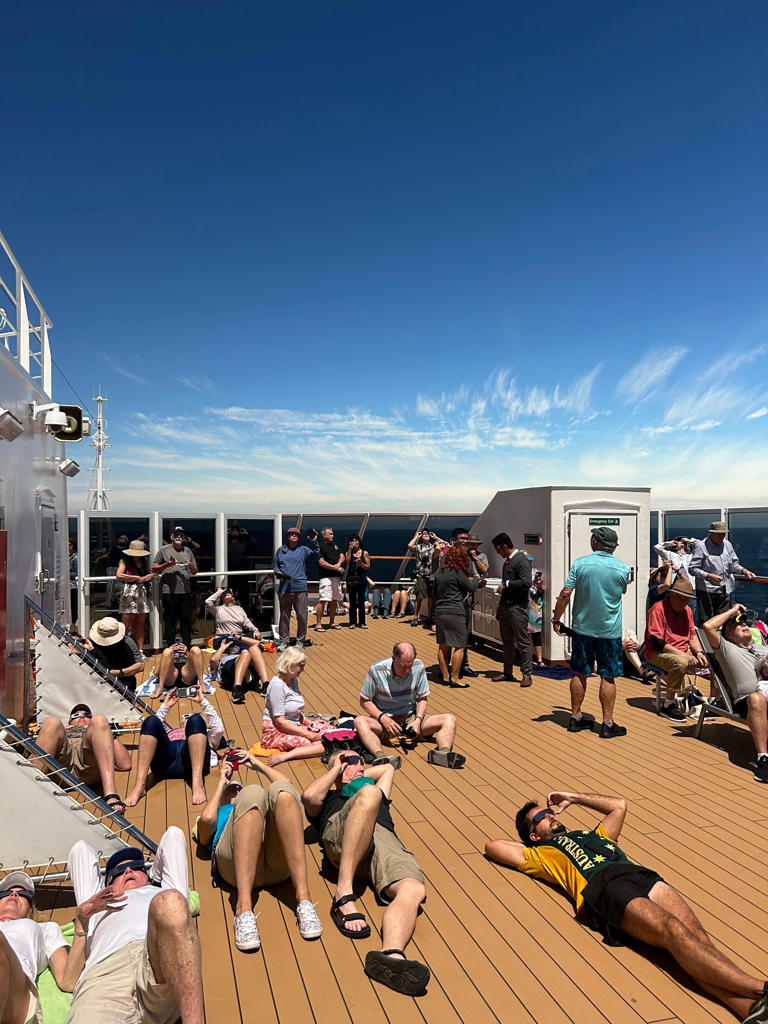
Bulgarian cruise ship crashes into wall on Danube in Austria, injuring 11
- Medium Text
The Reuters Daily Briefing newsletter provides all the news you need to start your day. Sign up here.
Writing by Dave Graham Editing by Frances Kerry
Our Standards: The Thomson Reuters Trust Principles. New Tab , opens new tab
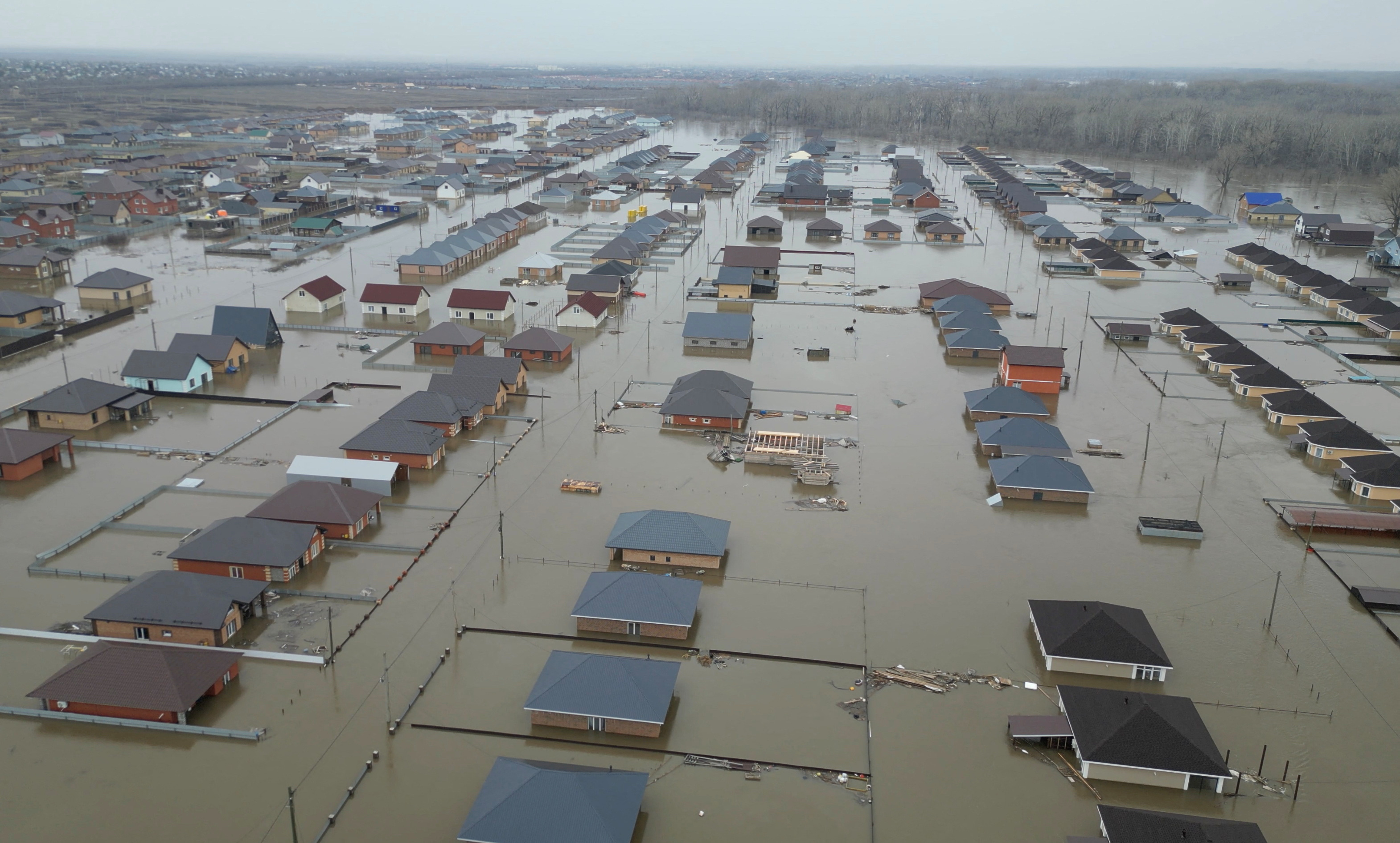
A man armed with a knife fatally stabbed one person and wounded another on Wednesday in the French southwestern city of Bordeaux, a government source briefed on the attack said.
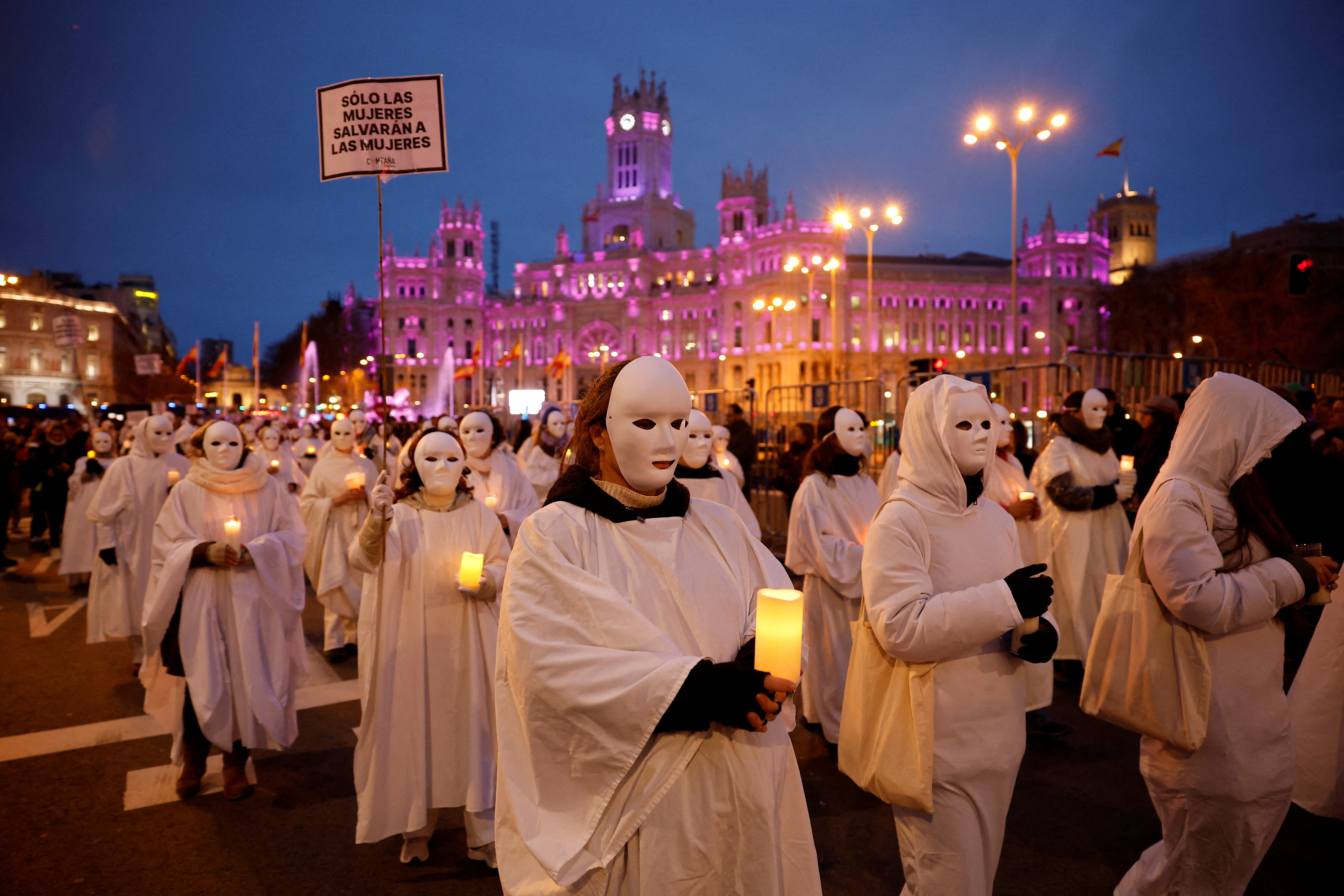
World Chevron

Opposition win in South Korea election to deepen policy stalemate for Yoon
South Korea's liberal opposition scored a landslide victory in a parliamentary election, vote counts showed on Thursday, dealing a resounding blow to President Yoon Suk Yeol and his conservative party but falling just short of a super majority.


IMAGES
VIDEO
COMMENTS
The engines on a cruise ship can be up to 45 feet long, 27 feet high, and weigh up to 275 tons. These massive engines can propel cruise ships at an average speed of 18-22 knots. Cruise Ship Engine Technology. Cruise ship engine technology has evolved from wind and sails to newer liquified natural gas technology.
In 2012, TUI used 54,463 tons of fuel, including 9,732 tons LSFO (low sulfur fuel oil), 40,880 tons HFO (heavy fuel oil) and 3,851 tons MDO (marine diesel oil). Fuel consumption was 0,367 tons per nautical mile. All new TUI ships are built to the latest standards with environmentally-friendly marine technologies.
The decibel range for the engine of a standard cruise ship exceeds 173 decibels. This is extremely loud and within a range that can damage hearing in seconds. Thanks to proper insulation and sound ...
This guide to cruise ship power systems will explain everything it takes to move cruise ships from port to port worldwide. Cruise ship power systems can vary from ship to ship, but every ship has an engine that uses fuel, usually diesel or gas, sometimes with supplemental electricity. If you have ever taken a cruise or seen one come into port ...
Most often, especially in newer cruise ships, the engines are located on the lower decks and towards the aft of the ship. They're not all the way in the back, but they are in the mid-aft area. Regardless of the size of the cruise ship, the engine in question is very, very loud. Fortunately, engineers can compensate for this by utilising sound ...
When it comes to cruise ships, the typical engine is a two 16-cylinder Wartsila 16V 46D which is a common rail engine. They also use three 12-cylinder Wartsila 12V 46D engines to power the ship ...
Conventional Diesel. Despite the colloquialism of "steaming to St. Thomas," the days of steam engines in ships have all but disappeared. (The last passenger ship built with a steam engine ...
This process, called bunkering, is a whole-team effort and is completed before the ship is ready to travel again. A small boat, a "barge," brings fuel to the 400 ports fueling for ships. Barge secures to the side of the cruise ship. Connects a hose between the ship tanks. Pumps fuel while watching guard.
Cruise ships require a lot of power. And rightfully so! As they carry close to 3000 passengers with 500-1000 crew members at any time. Most of the power of the ship is consumed by the large air-conditioning plant that takes care of passenger comfort in suites and public spaces. The propulsion plant of cruise ships, consisting of giant ...
The Engine Room. The engine room is the heart of a cruise ship. It is here that pistons hammer and crankshafts turn to propel the ship forward. It is the loud and oily place where the Chief Engineer and his team work around the clock to ensure that everything is running smoothly.
Cruise Ship Management Hierarchy. On today's cruise ships, in addition to the Captain being in charge, there are a handful of senior officers that manage the ship's operations and report to the Captain. These jobs include Staff Captain, Chief Engineer, Hotel Director, Cruise Director, Doctor, Food and Beverage Manager, and Staff Engineer.
Visiting the engine room of a cruise ship presents several benefits to passengers. Firstly, it offers a rare opportunity to witness firsthand the sophisticated technology and engineering marvels that power the vessel. Understanding the inner workings of a ship can be both educational and awe-inspiring, allowing passengers to gain a deeper ...
The lifeboats have two engines, port and starboard. They have communication tools for speaking to other ships and an internal PA system for making announcements. Next to the steering wheel are the fuel gauges and release hook which is a safety device that is used so the lifeboat can detatch itself from the ship.
Cruise ships are some of the largest ships on the water by volume and by the number of people carried, they have every other ship beat. The world's largest cruise ship, Harmony of the Seas, can ...
An average-sized cruise ship typically has a passenger capacity of around 2000-2500 and a crew complement of 600-1000, which is predominantly divided amongst the following departments, viz., Deck, Engineering, Food & Beverage, Housekeeping, Sanitation, Guest Services, Laundry, Spa, Medical, Entertainment, Photography, Merchandise, IT, HR, Shore ...
7,600 passengers (maximum capacity) [5] Crew. 2,350 [5] Icon of the Seas is a cruise ship built for Royal Caribbean International and is the lead ship of the Icon class. She entered service on 27 January 2024 out of the Port of Miami in the US. At 248,663 gross tonnage (GT), Icon of the Seas is the largest cruise ship in the world.
N orwegian Cruise Line forced an 80-year-old woman, who suffered a stroke and possible heart attack, to "medically disembark" on an African island and "left her to die," her family said.
pdmlynek. 1.1k. July 26, 2010. #2. Posted September 7, 2012. The quietness is one of the first things that I noticed when we were on our first cruise this summer. I did expect some low background noise from the engines, but if it was there, it was at a very low level (and this was on a 20-year old ship, which is likely noisier than newer ships).
Meanwhile, I have found a new watering hole for myself, the Swim & Tonic, the biggest swim-up bar on any cruise ship in the world. Drinking next to full-size, nearly naked Americans takes away one ...
The engine room on a cruise ship is often the most mysterious area of the vessel. It is where the powerful engines that propel the ship forward are housed, and it is also home to many of the electronic systems which keep a modern cruise ship running. On some of the larger ships, the engine room can occupy several decks and can be quite complex.
Seafaring is a tradition that encompasses a variety of professions and ranks. Each of these roles carries unique responsibilities that are integral to the successful operation of a seafaring vessel. A ship's crew can generally be divided into four main categories: the deck department, the engineering department, the steward's department, and other.The reasoning behind this is that a ship's ...
O ne of the American passengers who were left stranded in Africa when their cruise ship left the port without them now says she is unsure whether she even wants to resume the 20-day voyage, after ...
The current title holder of world's largest cruise ship is another vessel in the Royal Caribbean fleet, Wonder of the Seas, which made its inaugural voyage just last year and is a slightly ...
On average, contemporary cruise ships span well over 1,000 feet. Width, often called the beam, varies considerably but can surpass 100 feet for larger vessels, facilitating stability and space for onboard amenities. The wonder of engineering that is Royal Caribbean 's Wonder of the Seas stretches to a beam of 210 feet.
The structure collapsed when a cargo ship hit a pier, bringing down part of the main span and killing 35 people. Seven years later, a shrimp boat hit a bumper erected on the bridge built to ...
CruiseMapper provides free cruise tracking, current ship positions, itinerary schedules, deck plans, cabins, accidents and incidents ('cruise minus') reports, cruise news
The cruise line said that since the guests were on a private tour and missed the specified time, they are responsible for the cost of getting to the next available port of call to rejoin the ship.
Peter Greenberg's LIVE Global Travel Update - April 10, 2024 LIVE from Miami, my report on the latest in global travel news. Plus, my answers to your...
The cruise line also made the practicalities of watching an eclipse easier: eclipse glasses were distributed to guests' staterooms and Burgasser guided guests through the event via the ship's ...
Eleven people were injured when a Bulgarian cruise ship crashed into a concrete wall in a sluice on the River Danube in the northern Austrian town of Aschach an der Donau overnight, local police ...